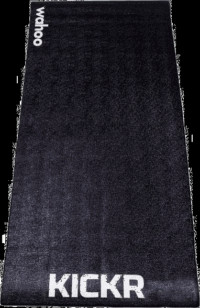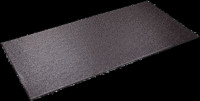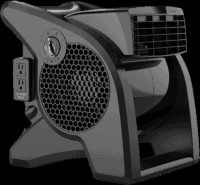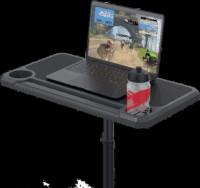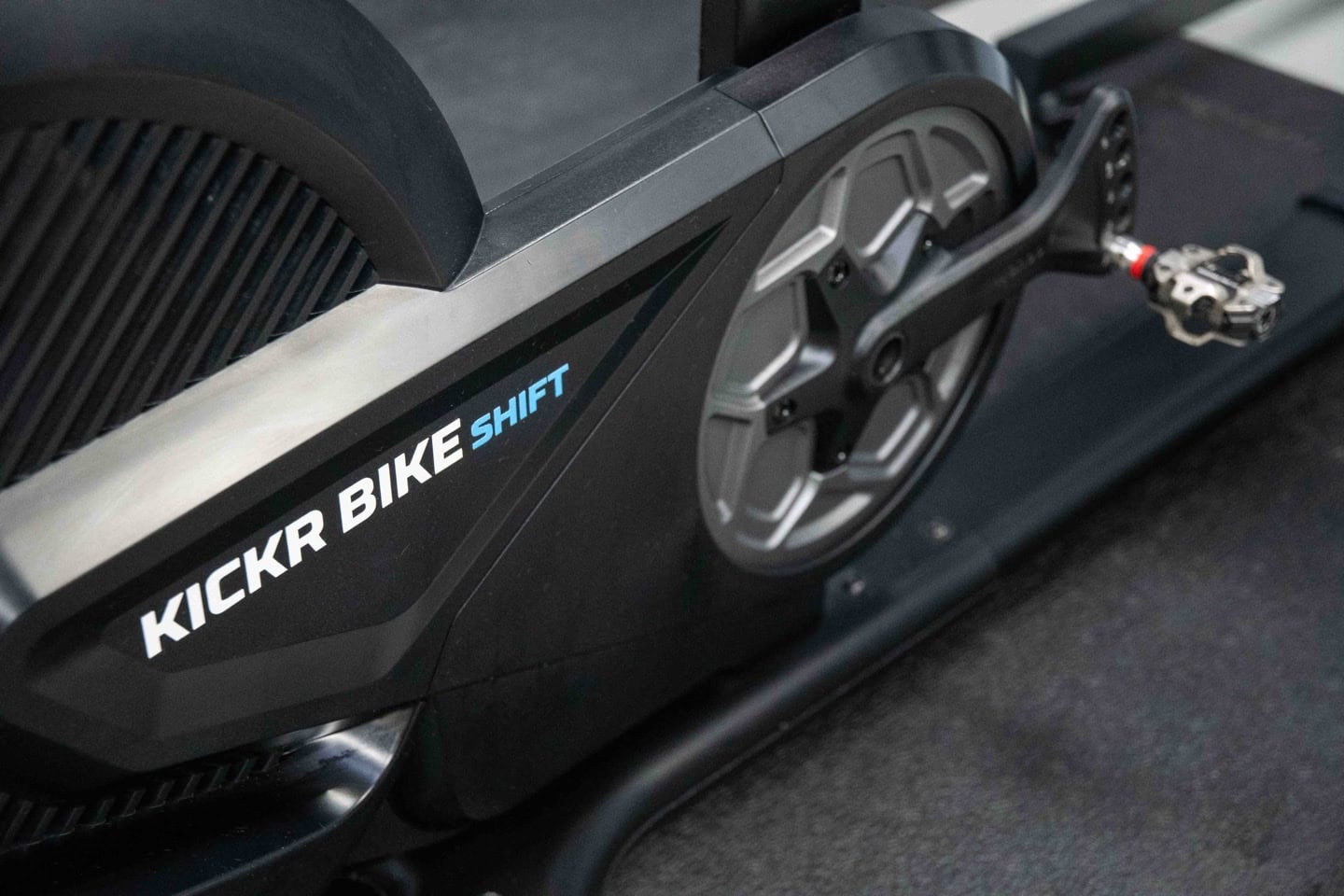
While this wasn’t initially planned as a long-term evaluation, here we are, nine months later, with a comprehensive review of the Wahoo Kickr Bike SHIFT. This smart bike emerges as a streamlined iteration of the original Wahoo KICKR BIKE, yet paradoxically, it surpasses its predecessor in several key aspects. Notably, it operates in near silence, boasts a simplified design with fewer potential points of failure, and comes with a more accessible price tag.
The KICKR BIKE SHIFT is strategically positioned as a more budget-friendly alternative to the flagship KICKR BIKE, priced at $2,999 compared to the $3,999 of its older, more feature-rich sibling. This cost reduction is achieved through the removal of certain hardware components. However, my extended experience with the SHIFT has led me to largely favor this more economical version.
My testing of the Wahoo KICKR BIKE SHIFT has been ongoing since last fall, even prior to its public announcement. Initial impressions, detailed in my first hands-on preview, revealed some power accuracy inconsistencies. These were addressed relatively quickly via a software update, yet sporadic accuracy issues persisted for about a month. Despite periods of reliable performance, unexplained accuracy deviations would occasionally resurface. However, after a series of subsequent software updates, these issues have been resolved for the past six to seven months. This sustained period of reliable performance warrants a conclusive, in-depth review.
Let’s delve into the specifics of the Wahoo KICKR BIKE SHIFT and explore what makes it a compelling option for indoor cycling enthusiasts.
Key Differences from the Original KICKR BIKE
 Wahoo KICKR Bike Shift and KICKR Bike V2 side-by-side, highlighting the design and component differences for potential buyers.
Wahoo KICKR Bike Shift and KICKR Bike V2 side-by-side, highlighting the design and component differences for potential buyers.
Before proceeding, it’s crucial to outline the distinctions between the KICKR BIKE SHIFT and the premium KICKR BIKE V2 launched in 2022. Parts of this section are adapted, with minor revisions, from my earlier first-look article.
Despite sharing the KICKR BIKE moniker with the V1 and V2 models, the SHIFT represents a significant departure in terms of technology and design. Virtually every aspect, from the frame geometry and materials to the flywheel and drivetrain system and even the electronic shifter mechanisms, has been re-engineered. The saddle (though even its mounting mechanism is different) and handlebars are among the very few carryovers from previous models, albeit with modified attachment methods.
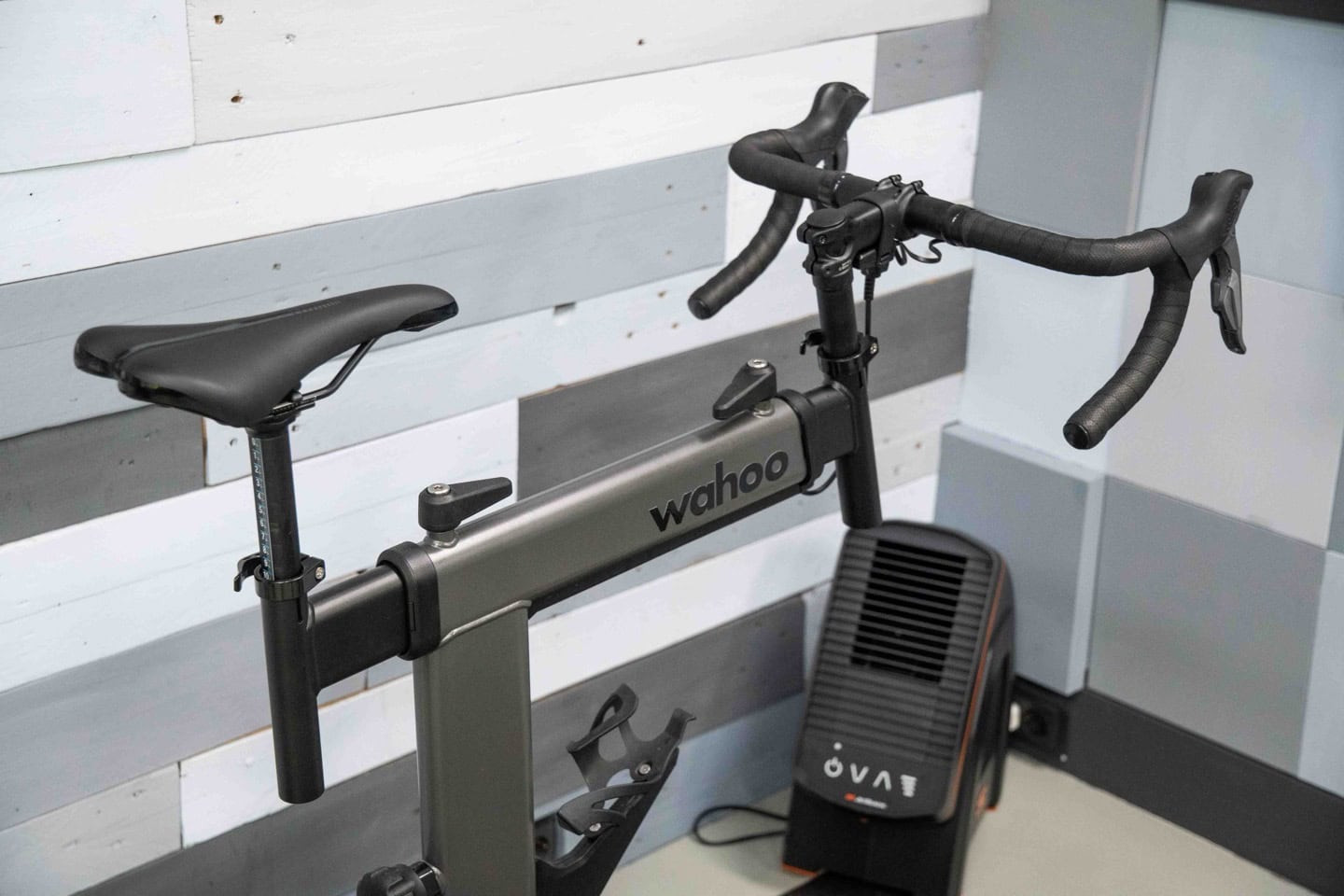 Close-up view of the Wahoo KICKR Bike Shift’s frame, showcasing the slimmer profile designed for enhanced rider comfort and compatibility.
Close-up view of the Wahoo KICKR Bike Shift’s frame, showcasing the slimmer profile designed for enhanced rider comfort and compatibility.
Starting with structural elements, the most immediate visual difference is the KICKR BIKE SHIFT’s (affectionately nicknamed KICKR Bike Jr.) noticeably slimmer profile. While this contributes to weight reduction – beneficial for both shipping costs and material savings – a key advantage is improved rider ergonomics. A frequent complaint with the KICKR BIKE V1/V2 was the overly wide top tube, which often caused thigh chafing, particularly for riders with certain body types. The redesigned, thinner frame of the SHIFT eliminates this issue, providing a more comfortable riding experience. I personally experienced no thigh rub during my extensive testing.
The SHIFT also incorporates newly designed adjustment handles throughout, reflecting its leaner construction. These new handles are neither superior nor inferior to the previous design; they are simply different and functionally adequate. Having used both the KICKR BIKE V1 at home and the KICKR BIKE SHIFT in the office, I have no strong preference for either handle style.
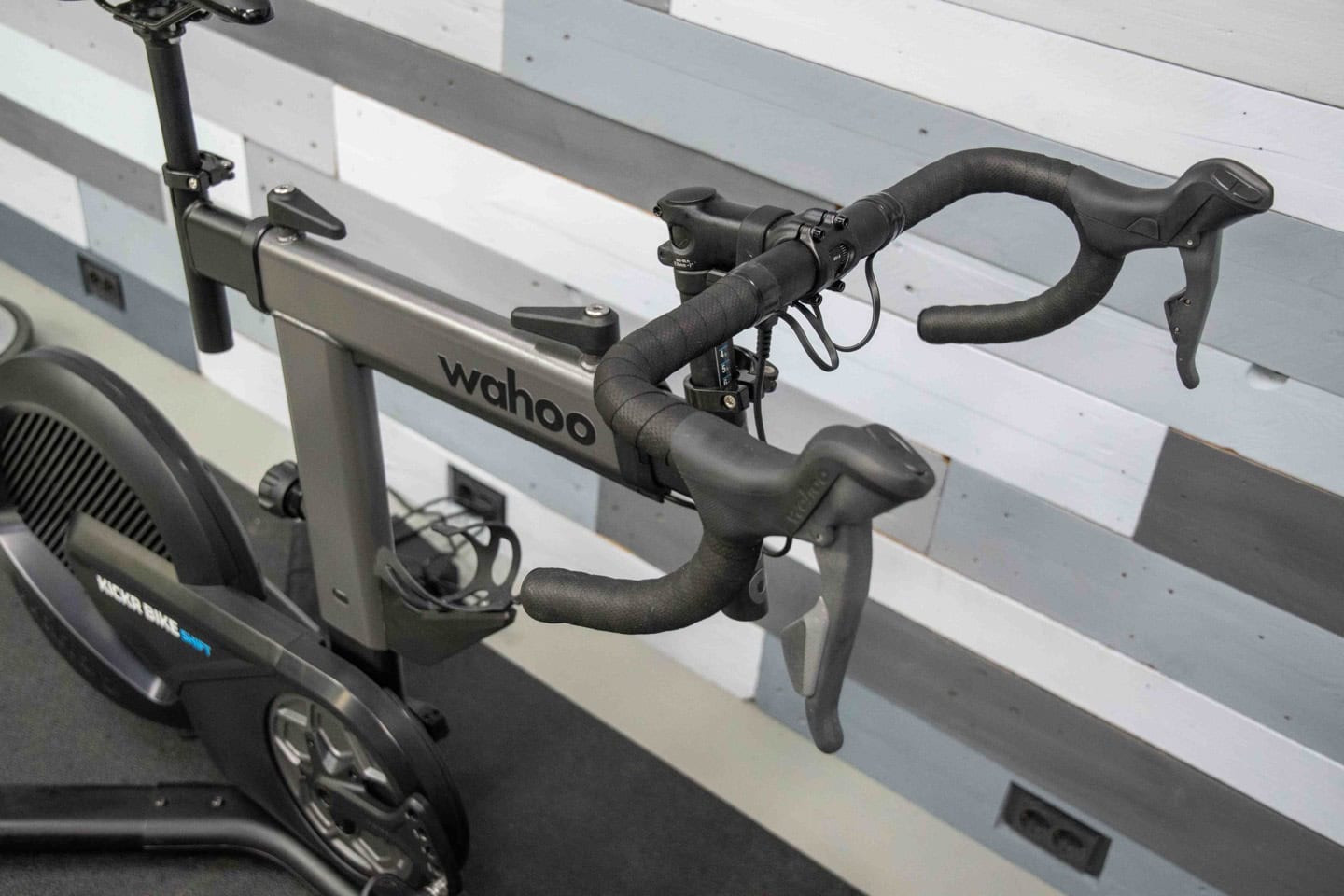 Detailed image of the Wahoo KICKR Bike Shift’s seat post clamp, featuring a hex-compatible nut for secure and slip-free adjustments.
Detailed image of the Wahoo KICKR Bike Shift’s seat post clamp, featuring a hex-compatible nut for secure and slip-free adjustments.
Another notable improvement is the redesigned seat post clamp, now featuring a hex-compatible nut. This allows for secure tightening with a hex wrench, effectively preventing slippage. Once properly tightened, the seat post remains firmly in place, even under vigorous riding conditions. In contrast, the KICKR BIKE V2, while equipped with a hand-friendly clamp, is more susceptible to seat post slippage.
Comparison of seat post clamps: KICKR BIKE V2 (left) and KICKR BIKE SHIFT (right):
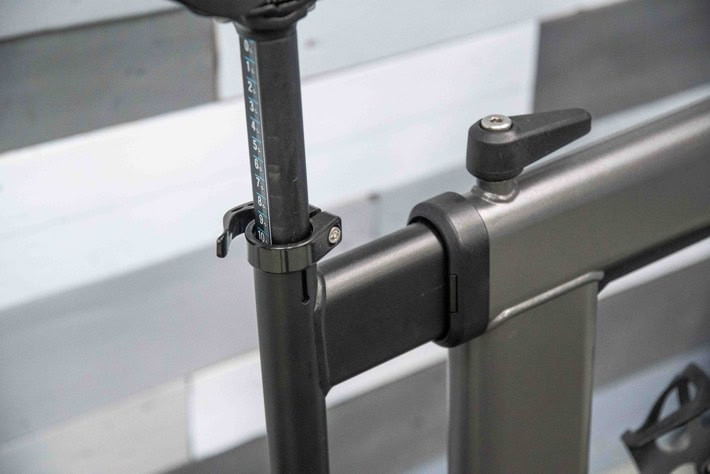 Side-by-side comparison of the seat post clamps on the Wahoo KICKR Bike V2 and the KICKR Bike Shift, highlighting the different tightening mechanisms.
Side-by-side comparison of the seat post clamps on the Wahoo KICKR Bike V2 and the KICKR Bike Shift, highlighting the different tightening mechanisms.
When inquiring about the consistency of fit markings between the KICKR BIKE V1/V2 and the KICKR BIKE SHIFT, Wahoo representatives indicated slight variations of a few millimeters. However, the Wahoo app compensates for these discrepancies. By inputting your fit coordinates, derived from a professional bike fitting or personal measurements, the app will generate accurate marker positions specific to the KICKR BIKE SHIFT.
Transitioning to electronic components, the front end of the SHIFT exhibits a cleaner aesthetic, devoid of exposed wiring. The previous generation’s cable clutter is replaced by a consolidated junction box, reminiscent of Di2/AXS systems. This unit serves as the central connection point for shifter cables, power supply, and wireless communication status indicators. It attaches magnetically:
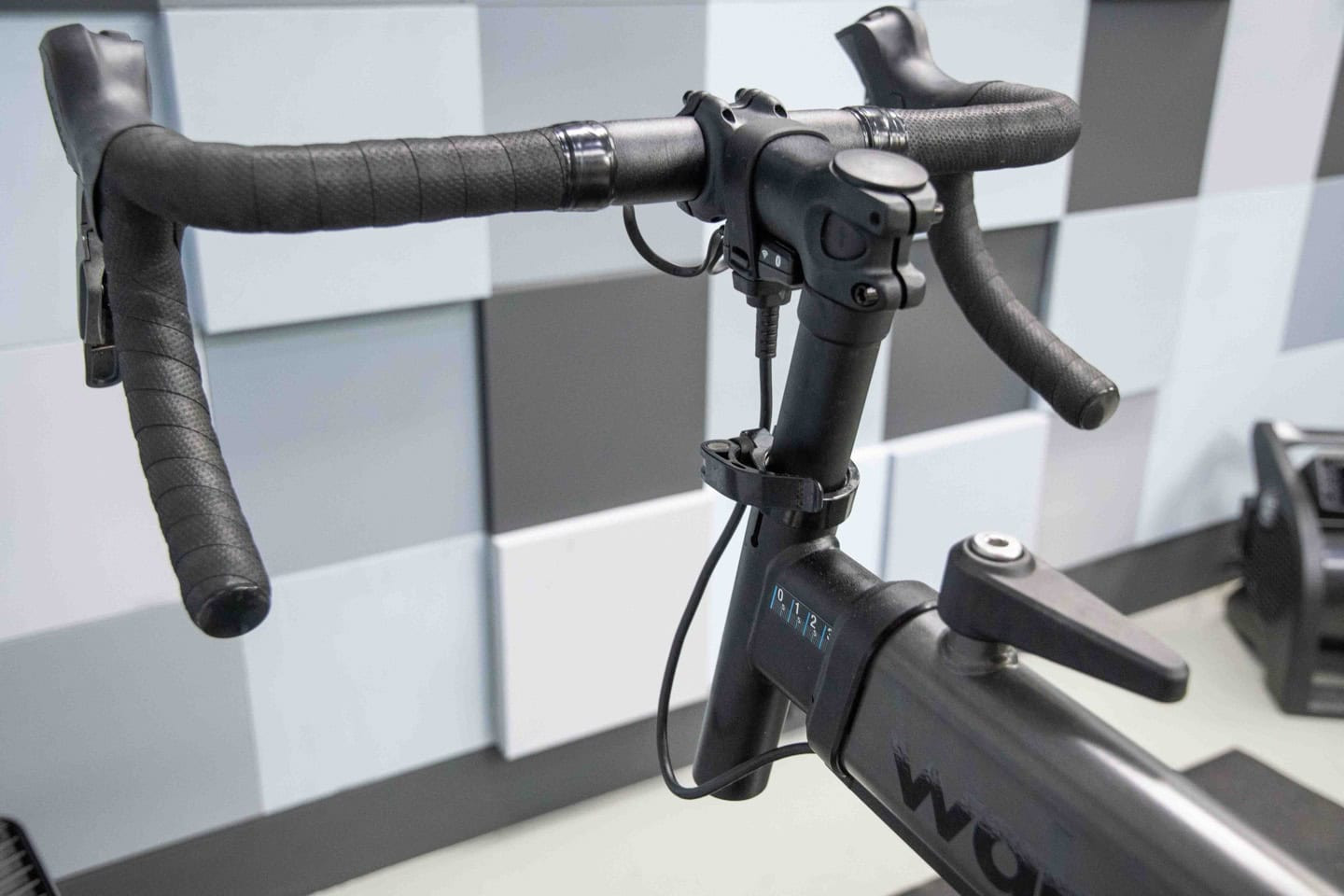 Close-up of the magnetic junction box on the Wahoo KICKR Bike Shift, showing the clean cable management and status lights for wireless connectivity.
Close-up of the magnetic junction box on the Wahoo KICKR Bike Shift, showing the clean cable management and status lights for wireless connectivity.
Despite initial concerns regarding the magnetic connection’s robustness and potential for accidental disconnection during rides (leading to power and data interruptions), I have not experienced any such issues. The magnetic attachment has proven to be secure and reliable throughout my testing period.
Moving to the rear of the KICKR BIKE SHIFT, we encounter the completely redesigned drivetrain and flywheel system. Unlike the motor-driven electromagnetic drivetrain of the KICKR BIKE V1/V2, the SHIFT employs a different mechanism. Consequently, it cannot simulate downhill momentum or coasting. Its operation is more analogous to Wahoo KICKR trainers. Visually, the new drivetrain is appealing. Any perceived “white” or reflective areas in images are simply studio lighting artifacts. In person, the unit is uniformly black, albeit with a glossy finish.
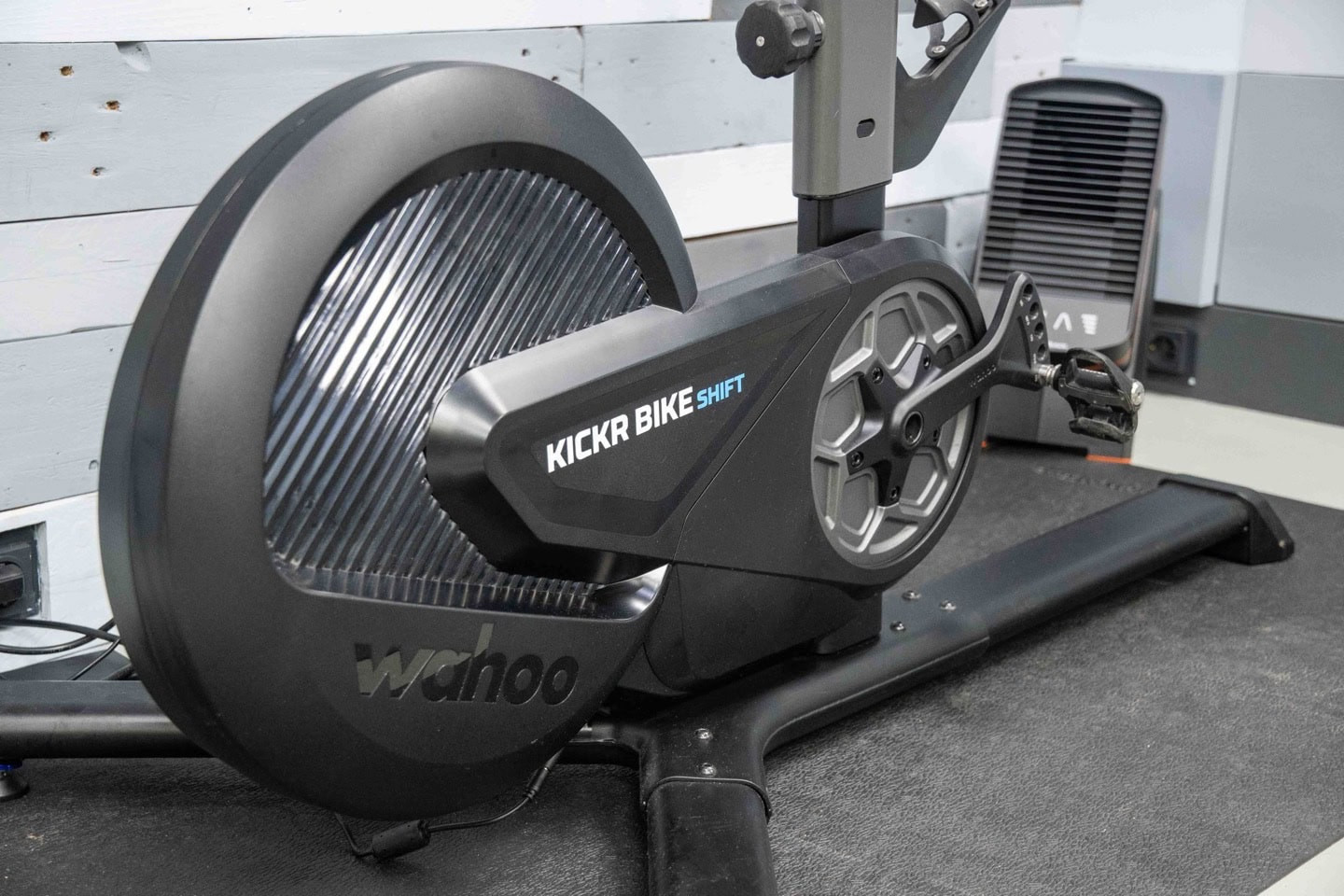 Rear view of the Wahoo KICKR Bike Shift’s new drivetrain and flywheel system, emphasizing its compact and silent design.
Rear view of the Wahoo KICKR Bike Shift’s new drivetrain and flywheel system, emphasizing its compact and silent design.
This new drivetrain system is remarkably silent. It produces virtually no noise during pedaling or coasting. The contrast is stark when switching to a KICKR BIKE V1 (or V2), immediately highlighting the SHIFT’s quiet operation.
This quietness extends beyond the drivetrain. The absence of built-in KICKR CLIMB gradient simulation further simplifies the mechanics, eliminating complex up/down mechanisms and pivot points. This simplicity contributes to the overall silent operation of the bike. This is a significant advantage over the KICKR BIKE V1 and V2, which are known to become progressively louder over time. My KICKR BIKE V1, for example, emits creaking and groaning noises even when stationary, escalating to considerable volume during use. In stark contrast, the KICKR BIKE SHIFT is exceptionally quiet, comparable to a Peloton Bike in its sound profile.
However, one immediate difference is the lack of a physical gear display on the KICKR BIKE SHIFT, a feature present on the KICKR BIKE V1/V2. This absence is particularly noticeable in Zwift, as the platform does not natively display gear selection for Wahoo KICKR Bikes (it does for Tacx NEO Bike, Wattbike, and potentially others), creating a missing feedback element.
Nearly a year ago, during my initial preview in September 2023, both Zwift and Wahoo indicated that gear display integration for the KICKR BIKE SHIFT was forthcoming. However, as of June 2024, this feature remains absent. Inquiries to both Zwift and Wahoo regarding the delay revealed that Zwift bears the primary responsibility. Progress is reportedly being made with updated protocol components being implemented within Zwift to facilitate gear display for trainer companies. Several companies are currently testing this integration internally. This updated integration is expected to enable Zwift to display KICKR BIKE SHIFT gear selection. However, considering that third-party developers have implemented similar functionality independently in a short timeframe, the year-long wait for this basic feature is less than ideal.
Finally, here’s a summary of the key technical specifications:
– Power Accuracy: +/- 1%
– Maximum Simulated Incline: 20%
– Maximum Resistance: 2,200w at 40KPH
– Calibration: Zero-calibration software algorithm
– Wireless Connectivity: Dual ANT+/Bluetooth Smart, including ANT+ FE-C, plus power/speed/cadence broadcasting
– Wired Connectivity: Built-in always-on WiFi (2.4 GHz), Retains KICKR Direct Connect wired port option (adapter required)
– Bike Weight: 100lbs/40kgs
– Maximum Rider Weight: 250lbs/113.4kgs
– Power Requirement: External power cable (must be plugged in)
– KICKR Race Mode: Not included (unlike KICKR BIKE V2)
With these distinctions outlined, let’s proceed to examine the unboxing and setup process.
Unboxing and Setup of the KICKR BIKE SHIFT
 Image of the Wahoo KICKR Bike Shift box, indicating the packaging and arrival condition of the smart bike for consumers.
Image of the Wahoo KICKR Bike Shift box, indicating the packaging and arrival condition of the smart bike for consumers.
Setting up the KICKR BIKE SHIFT is a straightforward process, neither complicated nor time-consuming. The main components – frame, legs, seat post, and handlebars – require assembly. Pedal installation is also required, allowing for personal pedal preference.
The initial step involves attaching the three legs to the main frame. Each leg is secured with a few bolts, providing a stable base for the bike.
 Step-by-step image of attaching the legs to the Wahoo KICKR Bike Shift frame, showing the initial assembly for stability.
Step-by-step image of attaching the legs to the Wahoo KICKR Bike Shift frame, showing the initial assembly for stability.
Next, you can choose to install either the seat post or handlebars. While the user manual likely specifies a preferred order, either approach is feasible. Each component simply slides into its designated receptacle and is secured with a quick-release lever.
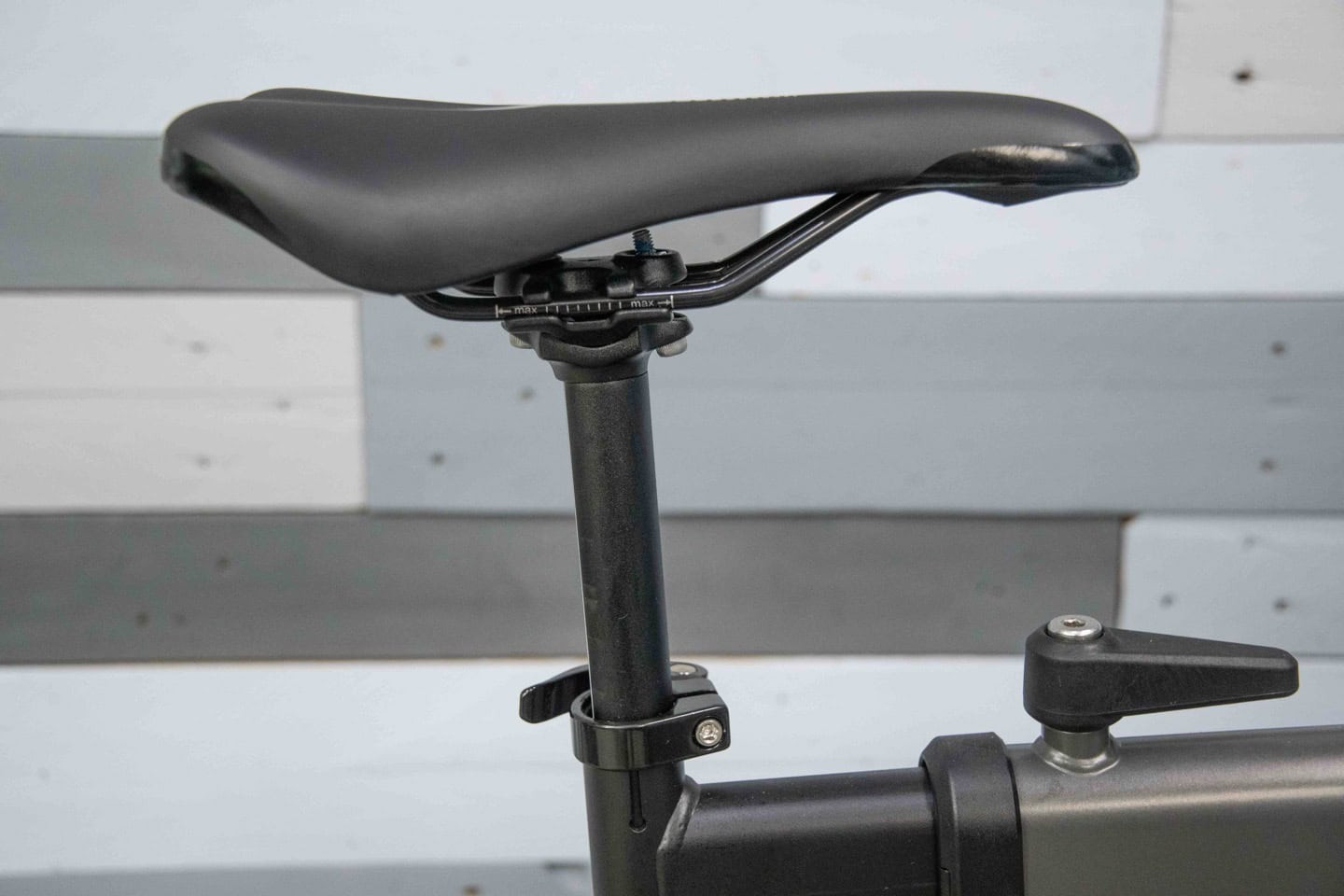 Image of installing the seat post onto the Wahoo KICKR Bike Shift, demonstrating the easy insertion and lever-based tightening mechanism.
Image of installing the seat post onto the Wahoo KICKR Bike Shift, demonstrating the easy insertion and lever-based tightening mechanism.
Subsequently, install the remaining component – seat post or handlebars – following the same procedure: insert into the designated opening and tighten the lever. Both the seat post and handlebars are designed for adjustability to accommodate riders of different sizes, a feature detailed further in the “Bike & Rider Fit Options” section.
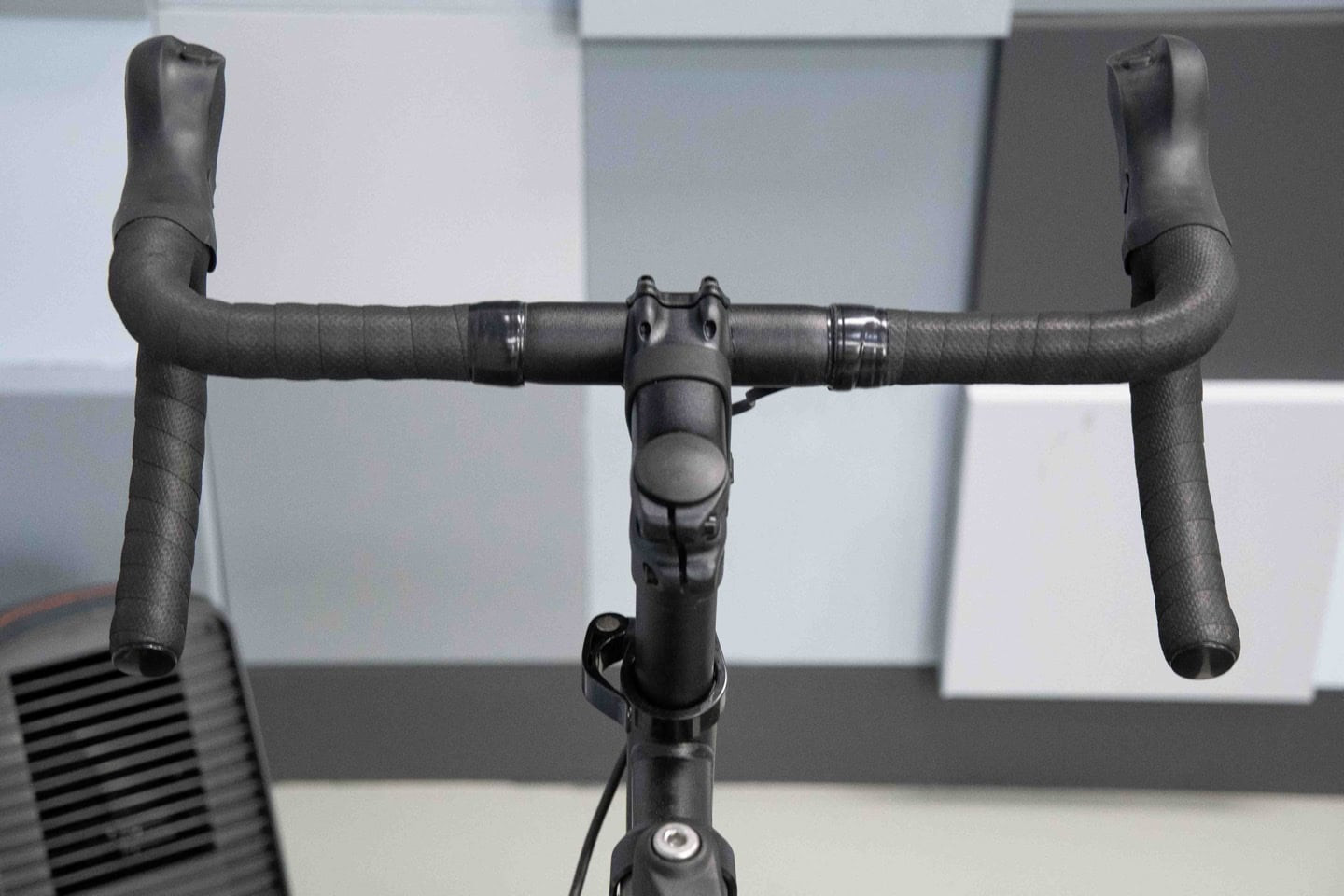 Image showing the handlebar installation on the Wahoo KICKR Bike Shift, highlighting the simple process and adjustability features.
Image showing the handlebar installation on the Wahoo KICKR Bike Shift, highlighting the simple process and adjustability features.
For handlebar installation, it’s necessary to connect the small magnetic cable. This cable powers the handlebar-mounted electronics and bike connectivity, routing power from the rear of the bike, past the resistance unit, and up to the handlebars via the magnetic mount system.
 Two images detailing the magnetic cable connection for the Wahoo KICKR Bike Shift handlebars, illustrating the power and data link setup.
Two images detailing the magnetic cable connection for the Wahoo KICKR Bike Shift handlebars, illustrating the power and data link setup.
The next step is connecting the power supply at the rear of the bike. One end plugs into the bike, located just below the flywheel housing, and the other end connects to a standard power outlet.
Finally, attach your preferred pedals to the crank arms, selecting the appropriate crank arm length setting. Crank arm length options and selection guidance are discussed in the following section.
With these steps completed, the KICKR BIKE SHIFT is ready for use.
Bike and Rider Fit Customization
 Overview of the Wahoo KICKR Bike Shift’s adjustable components, illustrating the range of customization options for different riders.
Overview of the Wahoo KICKR Bike Shift’s adjustable components, illustrating the range of customization options for different riders.
A significant advantage of indoor smart bikes is their suitability for shared use within households. Therefore, adjustability for diverse rider physiques is paramount, encompassing both the range of fit customization and the speed of adjustments for rider changes. Cumbersome adjustment processes discourage frequent use.
Wahoo has modified the adjustment handles on the SHIFT compared to the higher-end KICKR Bike, opting for a more conventional indoor bike lever design over sleek aesthetics. This functional change is unobtrusive and practical.
The KICKR BIKE SHIFT offers six primary adjustment points:
- Saddle height (vertical adjustment)
- Saddle position (fore/aft and saddle angle)
- Handlebar height (vertical adjustment)
- Handlebar position (fore/aft adjustment)
- Stand-over height adjustment (vertical adjustment)
- Crank length
It’s important to note that saddle height is a composite metric, influenced by both stand-over height and the actual saddle height setting.
Each adjustment point is marked with a ruler on one side, facilitating easy recording and memorization of individual rider settings.
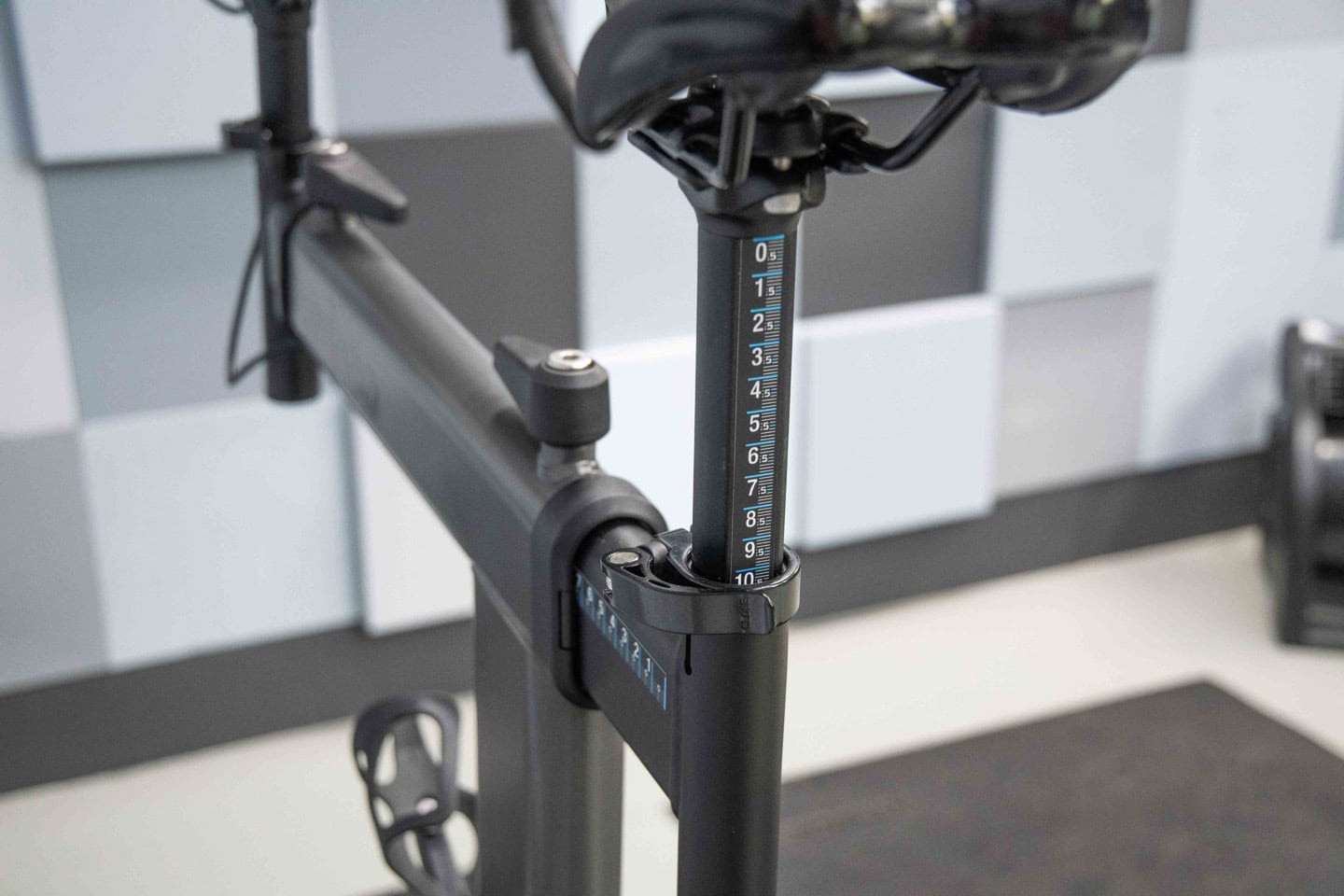 Close-up of the ruler markings on the Wahoo KICKR Bike Shift’s frame, aiding in precise and repeatable fit adjustments for multiple users.
Close-up of the ruler markings on the Wahoo KICKR Bike Shift’s frame, aiding in precise and repeatable fit adjustments for multiple users.
The adjustment clamps are designed to rotate freely, allowing them to be positioned out of the way and prevent leg interference.
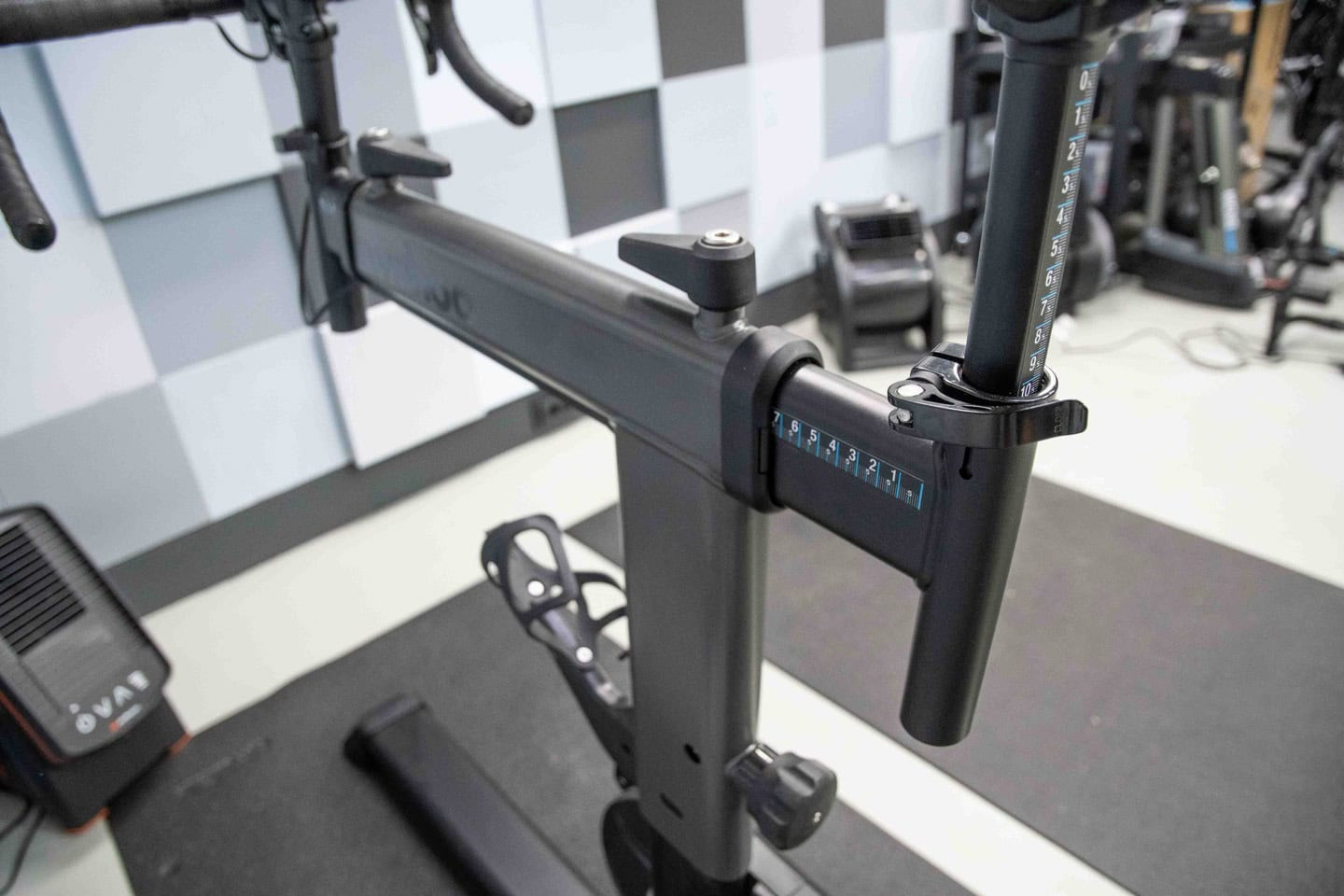 Image of the rotatable adjustment clamps on the Wahoo KICKR Bike Shift, showcasing their design to avoid rider interference during workouts.
Image of the rotatable adjustment clamps on the Wahoo KICKR Bike Shift, showcasing their design to avoid rider interference during workouts.
One notable modification on the SHIFT, compared to the higher-priced KICKR BIKE models, is the seat post clamp design. The new design allows for tool-assisted tightening, intended to mitigate seat post slippage. To some extent, this objective is achieved.
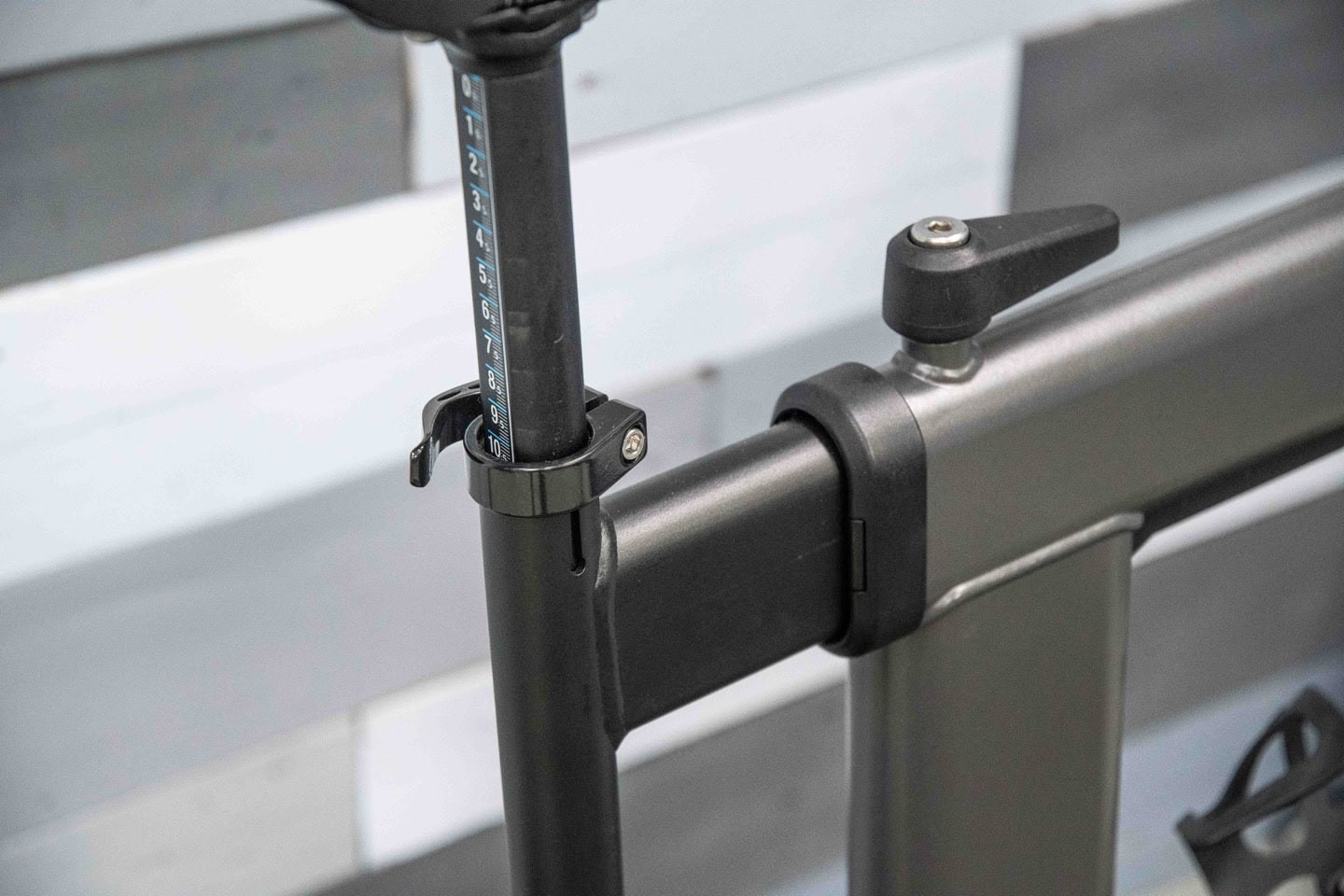 Detailed view of the improved seat post clamp on the Wahoo KICKR Bike Shift, designed for enhanced grip and reduced slippage.
Detailed view of the improved seat post clamp on the Wahoo KICKR Bike Shift, designed for enhanced grip and reduced slippage.
However, Wahoo’s continued use of a non-round seat post remains a point of concern. Presumably chosen for aesthetic reasons, this design inherently increases the risk of slippage unless significantly tightened. A simple solution is to replace the stock seat post with a standard round seat post, accommodating standard saddles. This is the approach I employ with my older KICKR BIKE V1 at home, where my wife and I use different saddles mounted on inexpensive, round seat posts.
To assist with initial fit setup, Wahoo provides a guided system within the Wahoo app, offering two methods:
A) Input height, inseam, and preferred riding position (relaxed, endurance, or race). The app then calculates and provides KICKR BIKE SHIFT measurements.
B) Utilize established bike fit system measurements from GURU Fit System, Retul Fit, or Trek Precision Fit. Input these measurements into the app to obtain corresponding SHIFT settings.
Screenshots of the Wahoo app fit guidance are shown below. The process is intuitive, although minor adjustments may be necessary after initial rides to fine-tune comfort.
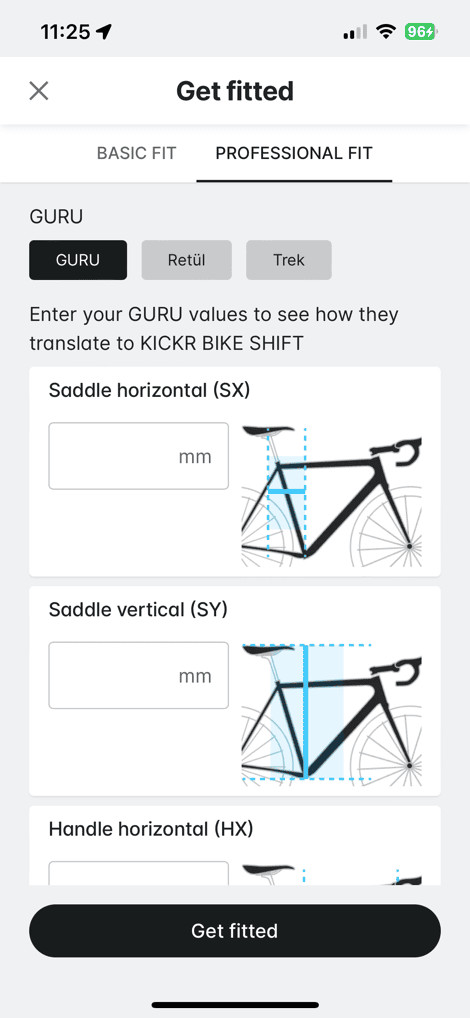 Screenshots from the Wahoo app showing the bike fit calculator and guided setup process for the KICKR Bike Shift, improving user experience.
Screenshots from the Wahoo app showing the bike fit calculator and guided setup process for the KICKR Bike Shift, improving user experience.
The app provides measurements as both numerical values on the bike’s rulers and alphanumeric codes (A/B/C/D, etc.) for stand-over height adjustment. Notably, the updated Wahoo app appears to have removed the feature that allowed users to photograph their existing bike and estimate fit coordinates from the image analysis.
One of the most appreciated fit enhancements on the KICKR BIKE SHIFT is the significantly slimmer top tube compared to previous KICKR BIKE models. The width of the earlier top tubes was a common source of thigh rub for many riders, making it the widest top tube among indoor bikes in the leg-contact area. The Tacx Bike, for example, avoids this issue with a top tube design that does not extend across the rider’s legs.
Another key fit aspect is crank length adjustability. The KICKR BIKE SHIFT uses a “bear-claw” style system, allowing pedals to be installed in various crank length positions: 165, 167.5, 170, 172.5, and 175mm. The Wahoo app can assist in selecting the appropriate crank arm length if needed.
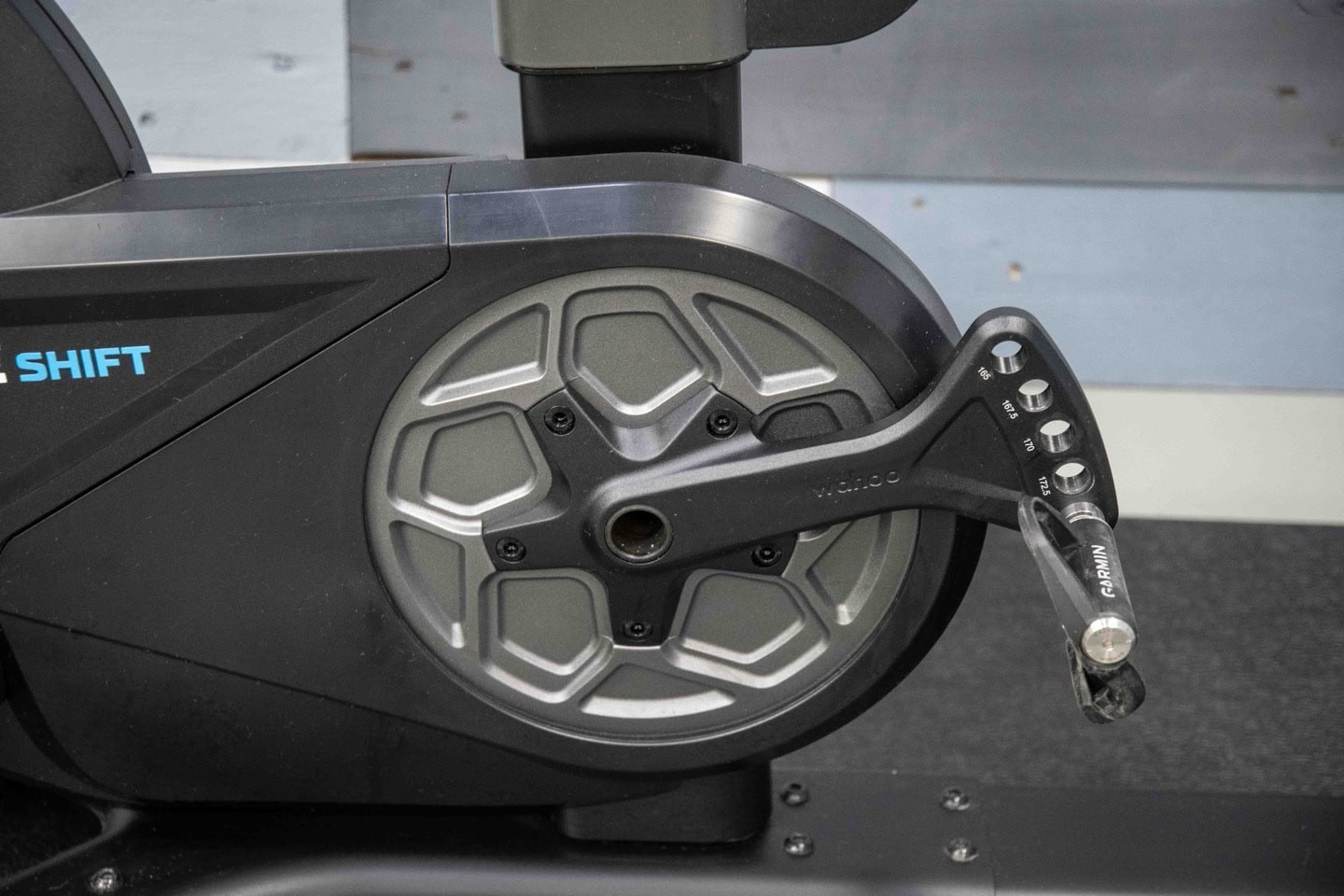 Image showing the crank arm with multiple pedal insertion points on the Wahoo KICKR Bike Shift, allowing for adjustable crank lengths.
Image showing the crank arm with multiple pedal insertion points on the Wahoo KICKR Bike Shift, allowing for adjustable crank lengths.
The crank length adjustment mechanism on the SHIFT has been simplified compared to earlier iterations, which featured more elaborate styling but potentially weaker points, possibly contributing to breakage issues reported by some users.
For triathletes, the KICKR BIKE SHIFT’s use of standard handlebars allows for easy installation of clamp-on aero bars. While I have not installed aero bars on the SHIFT, I have used them on my KICKR BIKE V1 at home, as shown in this earlier photograph:
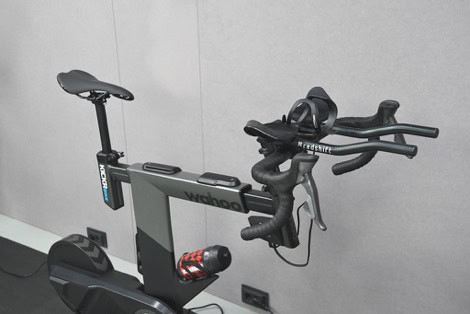 Image of aero bars installed on a Wahoo KICKR Bike, demonstrating the compatibility for triathlon training with the KICKR Bike Shift.
Image of aero bars installed on a Wahoo KICKR Bike, demonstrating the compatibility for triathlon training with the KICKR Bike Shift.
A limitation is the absence of remote shifters on either KICKR Bike model, necessitating handlebar shifter use for gear changes even with aero bars installed.
The Riding Experience on the KICKR BIKE SHIFT
 Action shot of a rider using the Wahoo KICKR Bike Shift, emphasizing the immersive and realistic indoor cycling experience.
Action shot of a rider using the Wahoo KICKR Bike Shift, emphasizing the immersive and realistic indoor cycling experience.
Let’s now explore the subjective aspects of riding the KICKR BIKE SHIFT on a day-to-day basis. This section will address “road-like feel,” movement dynamics, and basic logistical considerations. For in-depth technical details, such as communication protocols, refer to the “App Compatibility” section that follows.
Pairing with popular training applications is seamless with the KICKR BIKE SHIFT. Starting with Zwift, the most widely used platform, pairing is initiated by selecting the SHIFT as a power source and resistance trainer, followed by cadence and the “Steering/Controls” option for in-game steering functionality.
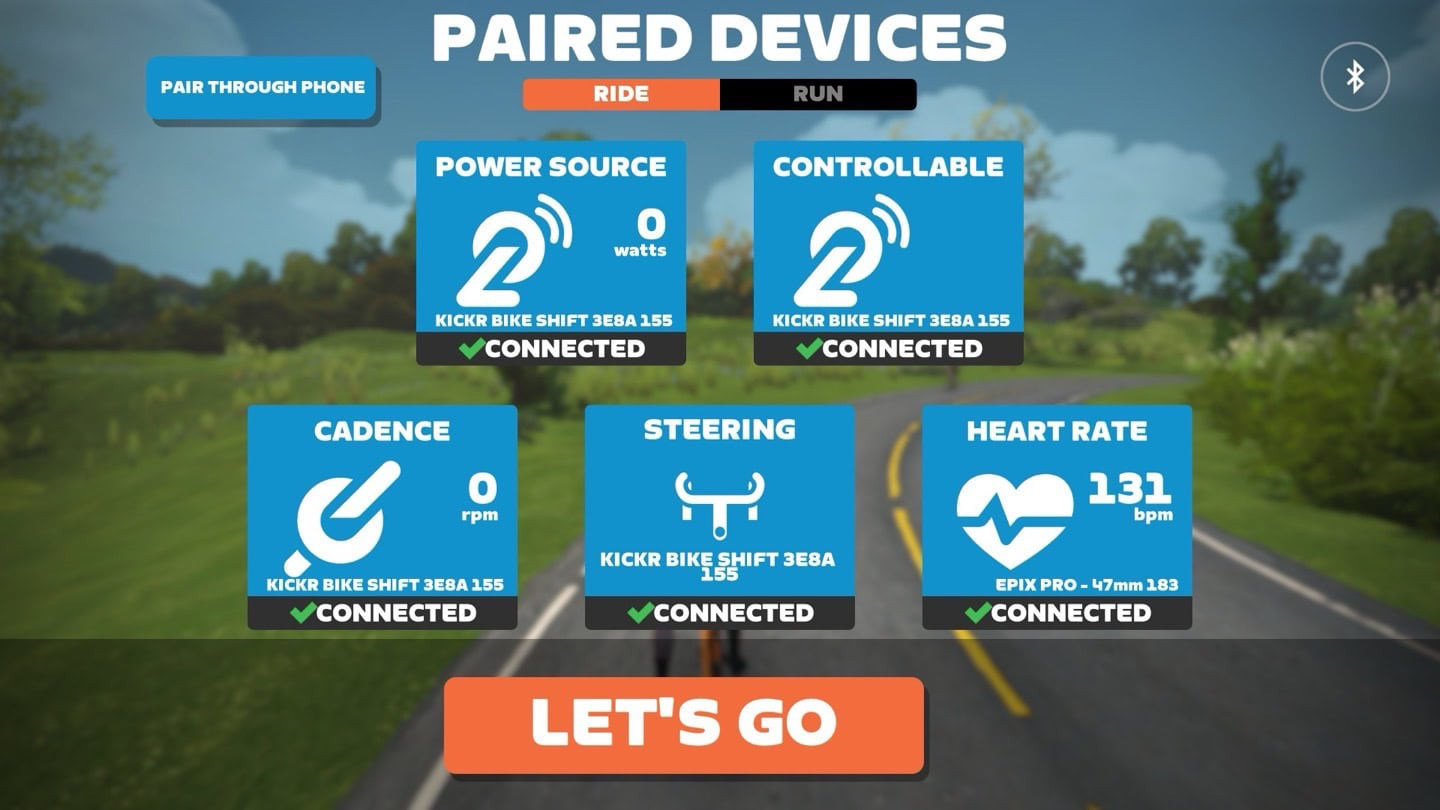 Screenshot of Zwift pairing screen, showing the Wahoo KICKR Bike Shift connected as a power source, trainer, and steering device for interactive training.
Screenshot of Zwift pairing screen, showing the Wahoo KICKR Bike Shift connected as a power source, trainer, and steering device for interactive training.
Before diving into virtual rides, it’s advisable to configure shifting preferences within the Wahoo Fitness app. The KICKR BIKE SHIFT offers three customizable shifting modes:
A) Sequential
B) Shimano (Di2 emulation)
C) SRAM (AXS/eTAP emulation)
Within these modes, you can create specific bike gearing profiles by selecting from common chainring and cassette combinations or creating custom configurations. (Note: The “Life Odometer” reading of 0km in my app is inaccurate and does not reflect actual mileage).
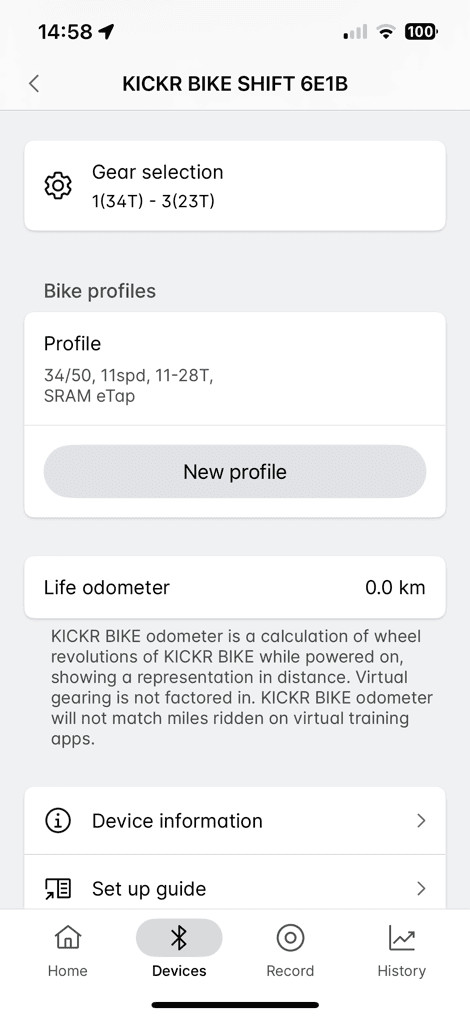 Screenshot from the Wahoo Fitness app, showing the gear customization options for the Wahoo KICKR Bike Shift, allowing personalized cycling setups.
Screenshot from the Wahoo Fitness app, showing the gear customization options for the Wahoo KICKR Bike Shift, allowing personalized cycling setups.
Multiple bike and rider profiles can be created within the app. However, it’s crucial to remember to switch to the correct profile before starting a ride in Zwift or other applications. Ideally, these apps would allow quick profile selection in-game or even link profiles to virtual bikes, eliminating the need for pre-ride adjustments in the Wahoo app. IndieVelo offers a partial solution, allowing some shifting and gearing adjustments within the application.
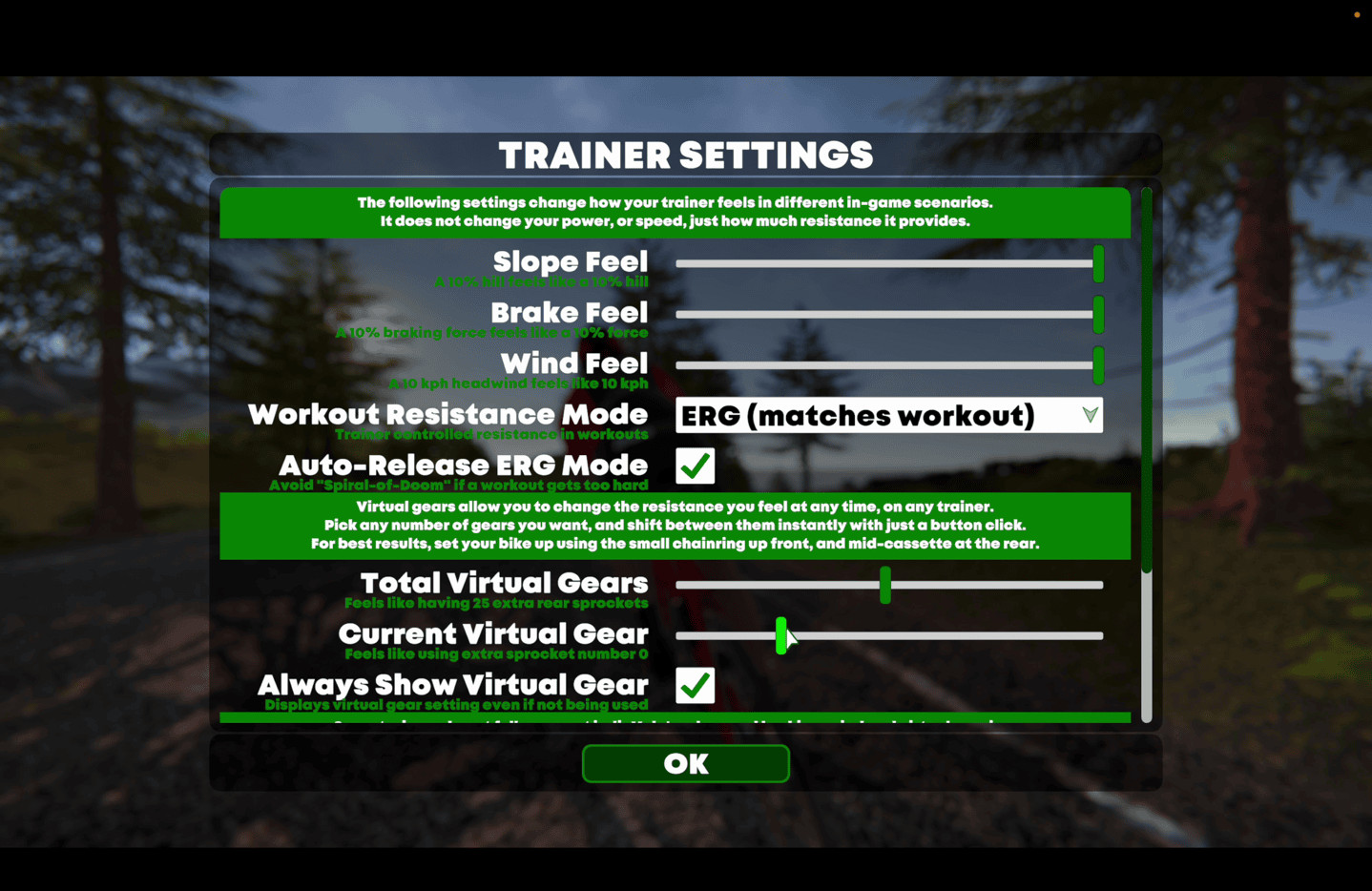 IndieVelo interface displaying customizable gearing and shift settings for the Wahoo KICKR Bike Shift, demonstrating in-app adjustment capabilities.
IndieVelo interface displaying customizable gearing and shift settings for the Wahoo KICKR Bike Shift, demonstrating in-app adjustment capabilities.
With setup complete, you can begin riding in your chosen virtual environment. The image below shows Zwift in simulation mode (SIM mode), which replicates the gradient of virtual routes. For example, when encountering a 5% incline, the trainer automatically adjusts resistance to simulate the hill climb. The intensity of this simulation is influenced by the “Trainer Difficulty” setting in Zwift, which defaults to 50%. At the default setting, a 5% hill will feel more like a 2.5% incline.
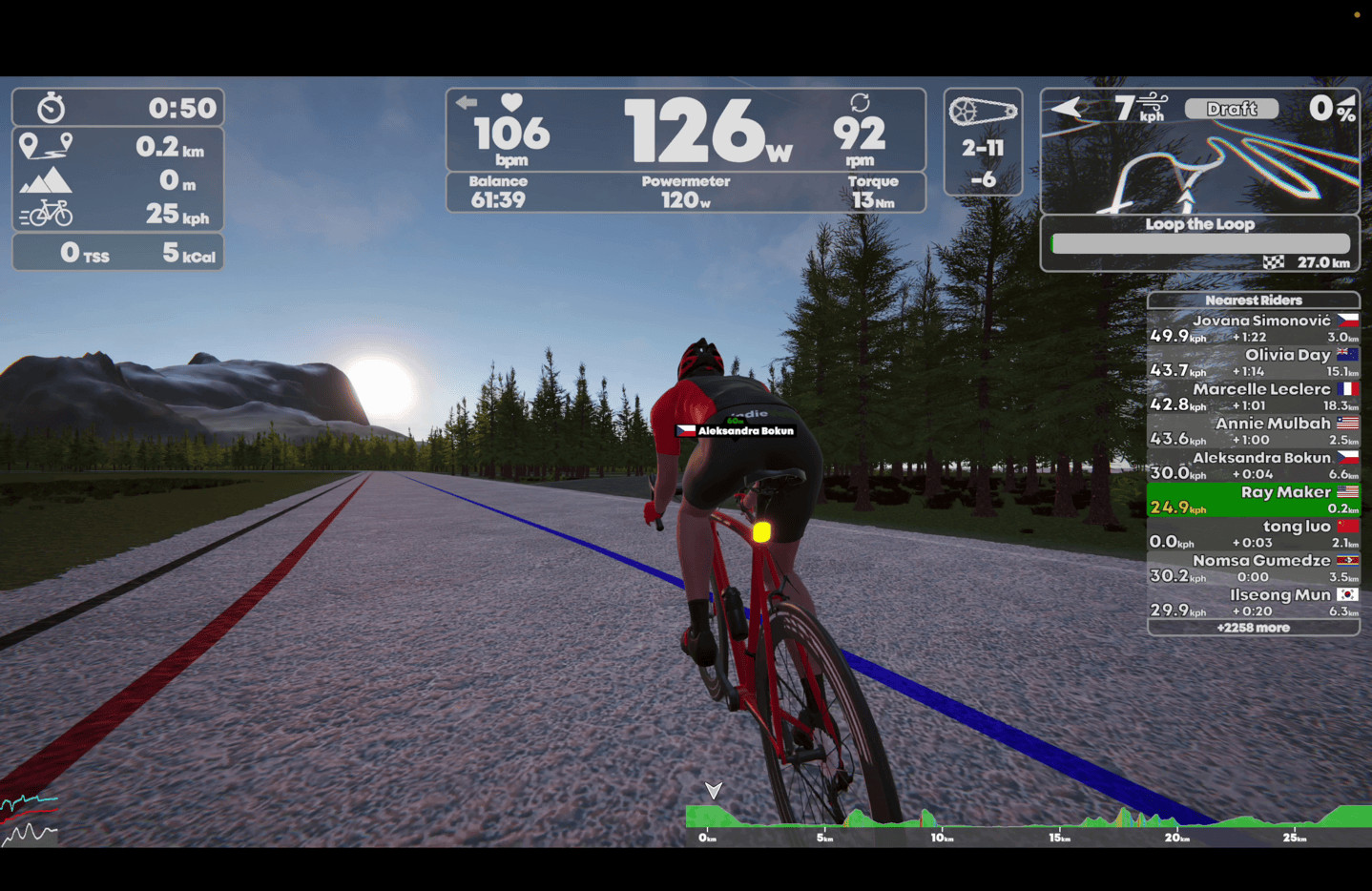 Zwift in simulation mode with the Wahoo KICKR Bike Shift, illustrating the virtual environment and gradient simulation during a ride.
Zwift in simulation mode with the Wahoo KICKR Bike Shift, illustrating the virtual environment and gradient simulation during a ride.
Unlike the KICKR BIKE V1 & V2, the SHIFT does not physically tilt or elevate the bike to simulate inclines. While the physical up/down motion of the KICKR CLIMB feature in the V1/V2 is engaging, its absence in the SHIFT is not a significant drawback for many users. Anecdotally, many KICKR Bike owners, including myself, often forget to enable or utilize the incline simulation feature before rides. While some riders appreciate this feature, it’s not universally considered essential.
Regarding “road-like feel,” the KICKR BIKE SHIFT performs admirably in replicating acceleration and deceleration dynamics. Sprints feel realistic and responsive. This is noteworthy because the SHIFT employs a different resistance technology than the KICKR BIKE V1 & V2. The SHIFT is more akin to Wahoo KICKR smart trainers, while the V1/V2 utilize an electromagnetic system similar to Tacx NEO devices. In most riding scenarios, the difference is imperceptible. However, one key distinction is downhill simulation. The KICKR BIKE V1/V2 can actively propel the flywheel forward during descents, creating a downhill coasting sensation. In contrast, the SHIFT’s flywheel will gradually decelerate to a stop if pedaling ceases, similar to riding on flat terrain.
Again, the absence of active downhill simulation is unlikely to be noticed by riders unfamiliar with this feature. However, those accustomed to it may or may not miss it, depending on personal preference.
Beyond SIM mode, the KICKR BIKE SHIFT excels in ERG mode for structured workouts. In ERG mode, the bike precisely controls resistance to maintain target wattages specified by the workout protocol. The image below shows the SHIFT under ERG control in IndieVelo. As with any smart trainer or bike, minor fluctuations around the target wattage are normal due to variations in pedaling input. However, the SHIFT maintains consistent and accurate power delivery.
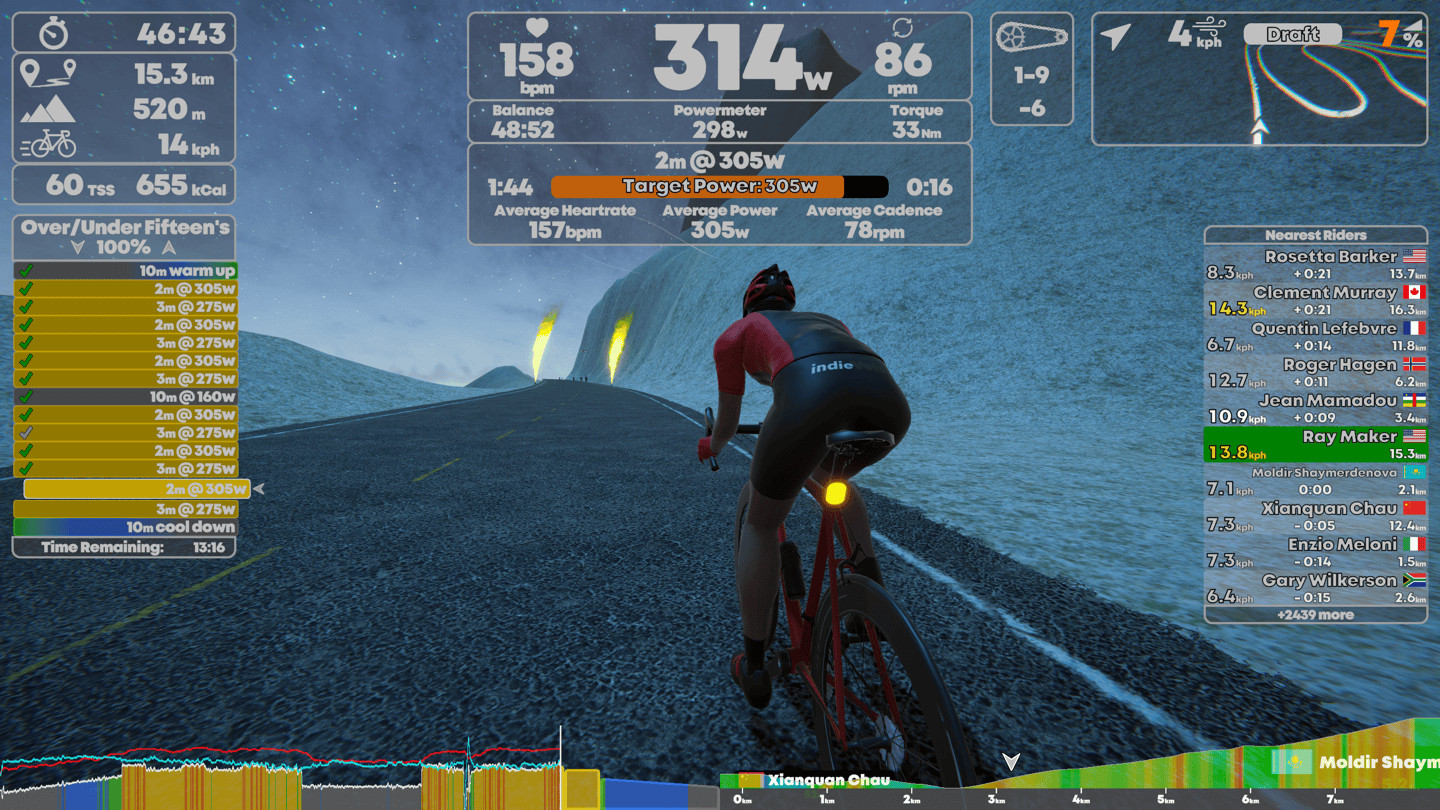 IndieVelo workout screen showing the Wahoo KICKR Bike Shift in ERG mode, displaying power output and structured workout control.
IndieVelo workout screen showing the Wahoo KICKR Bike Shift in ERG mode, displaying power output and structured workout control.
Regarding noise, the KICKR BIKE SHIFT is exceptionally quiet, a significant advantage over the KICKR BIKE V1/V2, which tend to become noisier with use. The V2 is quieter than the V1, particularly over time, but both are considerably louder than the SHIFT. The SHIFT’s near-silent operation is demonstrated in this prior noise test:
 Thumbnail of a noise test video for the Wahoo KICKR Bike Shift, emphasizing its quiet operation compared to other smart bikes.
Thumbnail of a noise test video for the Wahoo KICKR Bike Shift, emphasizing its quiet operation compared to other smart bikes.
Returning to shifting and braking, the KICKR BIKE SHIFT handlebars and shifters are well-designed and functional. The shifters provide tactile feedback and a realistic cycling feel, unlike purely button-based systems. This tactile engagement is crucial for an immersive smart bike experience, differentiating it from purely gamified interfaces.
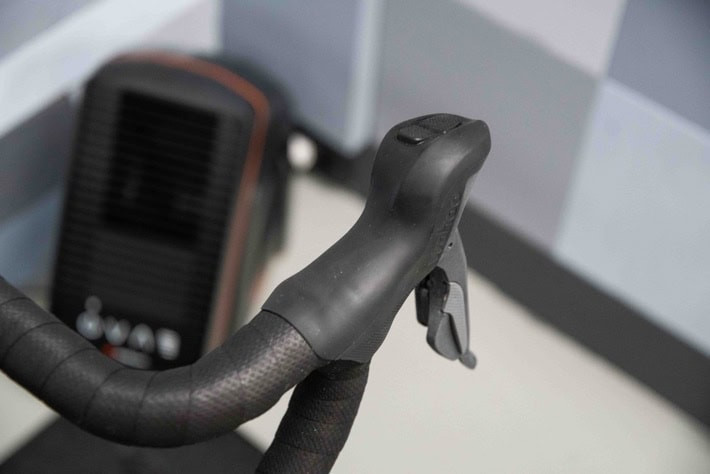 Close-up images of the Wahoo KICKR Bike Shift handlebars and shifters, highlighting the realistic design and tactile feedback for gear changes.
Close-up images of the Wahoo KICKR Bike Shift handlebars and shifters, highlighting the realistic design and tactile feedback for gear changes.
The shifters provide a distinct “click” sensation, mimicking real bike shifters. As mentioned earlier, shifting can be configured to emulate Shimano or SRAM systems. The integrated brakes on the handlebars can be used to decelerate your avatar in most virtual cycling environments. While virtual braking may not be frequently used, the functionality is present.
Steering within games that support it is controlled by the inner buttons located on each shifter. These buttons allow lateral movement within designated lanes in the virtual world, depending on the game’s steering implementation.
Finally, concerning movement and bike feel, the KICKR BIKE SHIFT lacks rocker-plate functionality. Therefore, it does not offer the same degree of motion as trainers like the KICKR MOVE or setups incorporating rocker plates. However, the frame design does allow for some inherent sway. The overall movement is satisfactory and does not detract from the riding experience.
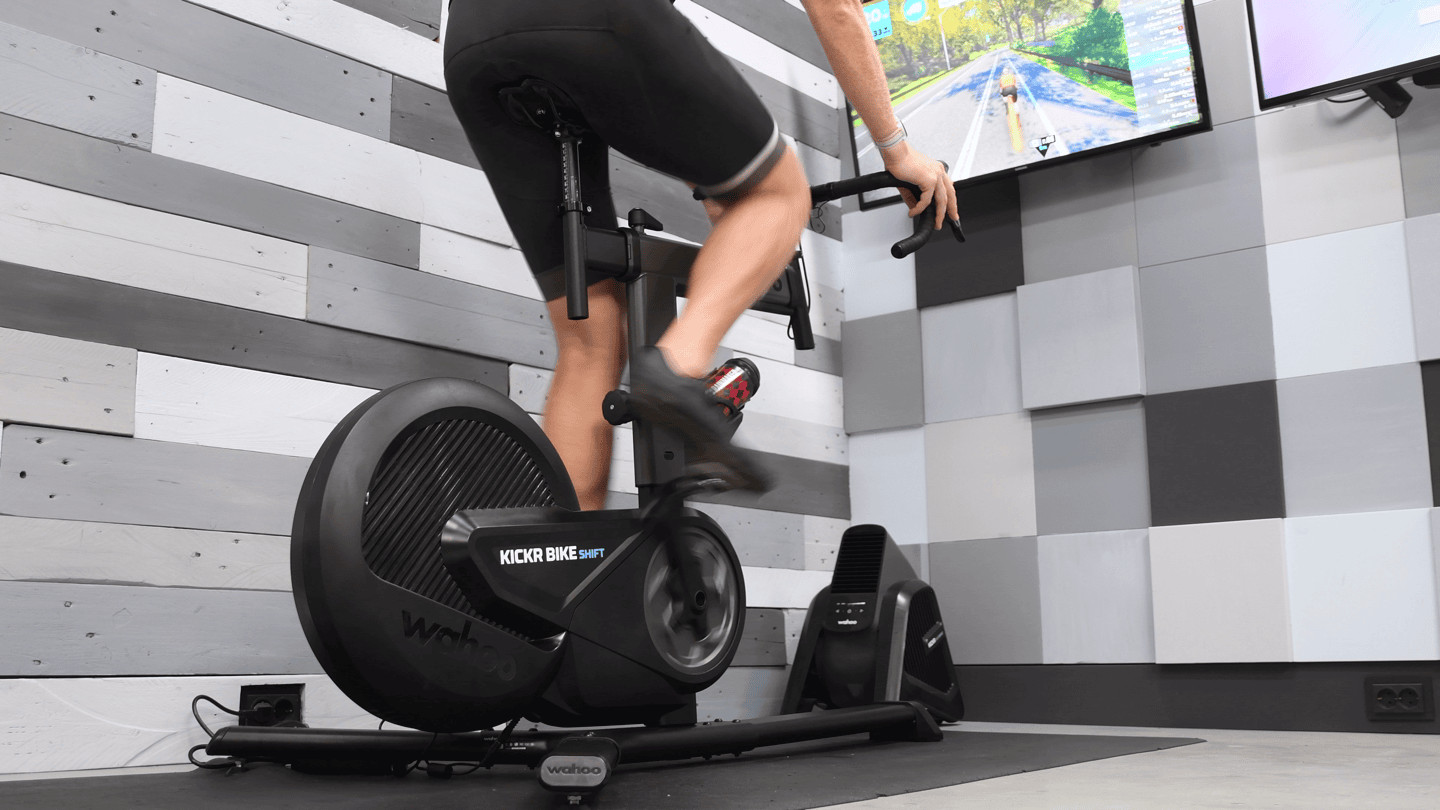 Rider in action on the Wahoo KICKR Bike Shift, showcasing the bike’s stability and natural riding position during intense training.
Rider in action on the Wahoo KICKR Bike Shift, showcasing the bike’s stability and natural riding position during intense training.
Regarding stability, the KICKR BIKE SHIFT is robust and unlikely to tip over during normal use, even for taller riders. The stable base design inspires confidence during vigorous workouts. Unintentional tipping would likely require extreme and atypical movements.
App Compatibility and Connectivity
The Wahoo KICKR BIKE SHIFT adheres to industry standards for interoperability, ensuring compatibility with a wide range of training applications. Platforms such as Zwift, TrainerRoad, IndieVelo, Rouvy, FulGaz, Kinomap, and many others support these standards, providing users with flexibility in their software choices. Trainers and apps that deviate from these standards create compatibility challenges for users.
Specifically, the KICKR BIKE SHIFT supports the following communication protocols:
ANT+ FE-C Trainer Control: Enables trainer control via ANT+ from compatible apps and head units.
ANT+ Power Meter Broadcast: Broadcasts power data via ANT+, allowing connection to watches and bike computers for data recording independent of trainer control.
Bluetooth Smart FTMS: Facilitates trainer control via Bluetooth from apps like Zwift and others.
Bluetooth Smart Power Meter Broadcast: Broadcasts power data via Bluetooth, primarily for Bluetooth-only devices such as Apple Watches or Polar/Suunto watches.
WiFi Direct Connect: Integrated WiFi allows direct network connectivity for game interactions and firmware updates.
Ethernet Direct Connect (with adapter): Optional Ethernet adapter enables wired network connection for enhanced reliability.
Cadence data is integrated into all connection protocols, eliminating the need for separate cadence sensors. When pairing the KICKR BIKE SHIFT with an app, the cadence channel is automatically included.
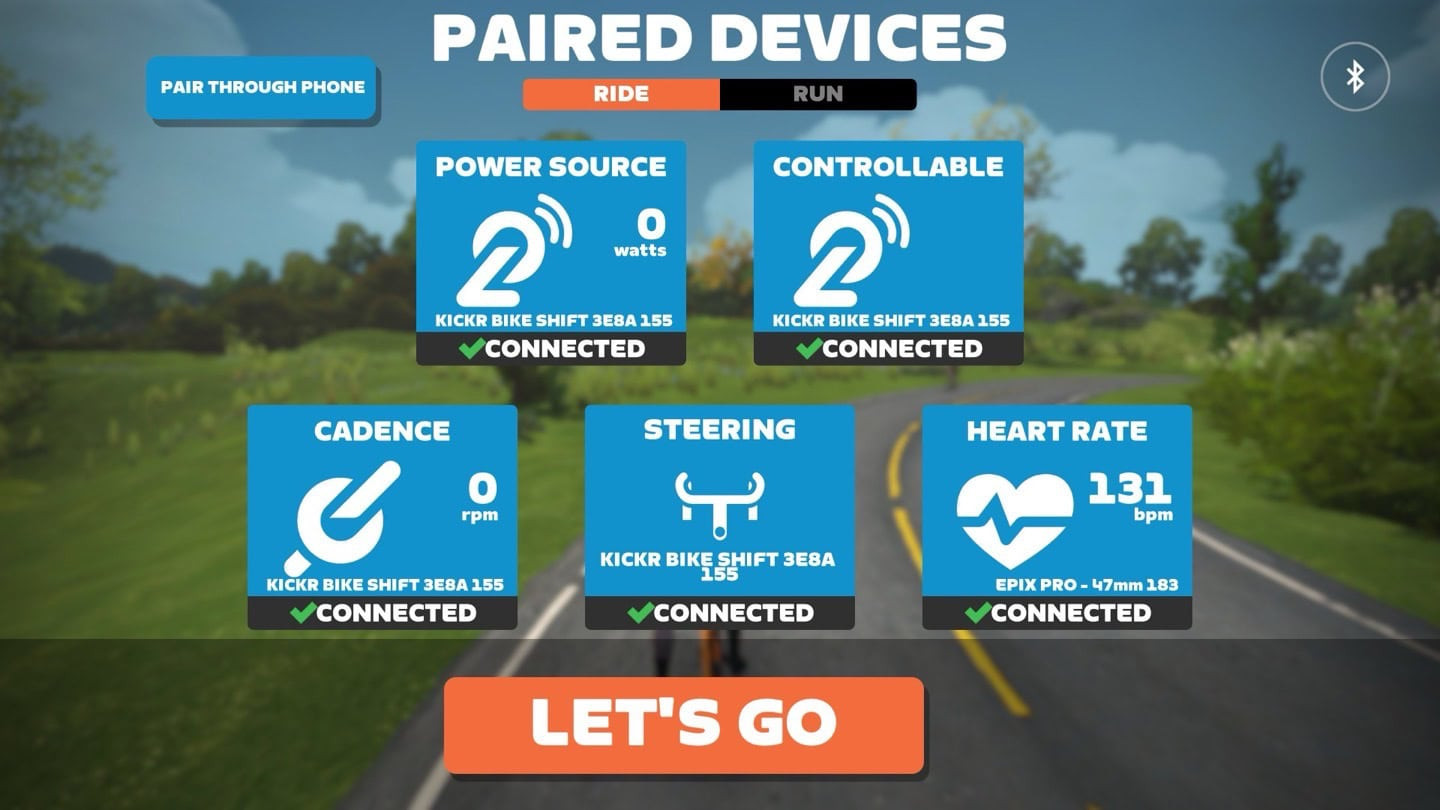 Screenshot of app pairing screen showing Wahoo KICKR Bike Shift connection options, including power, cadence, and trainer control via ANT+ and Bluetooth.
Screenshot of app pairing screen showing Wahoo KICKR Bike Shift connection options, including power, cadence, and trainer control via ANT+ and Bluetooth.
These standards also enable connectivity with bike computers. Wahoo and Garmin bike computers with ANT+ FE-C or Wahoo Bluetooth Smart trainer control can be used to re-ride outdoor routes indoors. However, this functionality is less commonly used given the rich features of modern training applications.
During my testing, I primarily used Zwift, IndieVelo, and TrainerRoad. In Zwift and IndieVelo, I tested both SIM mode (gradient simulation) and ERG mode (structured workouts). TrainerRoad testing focused on ERG mode. The SHIFT paired seamlessly with IndieVelo:
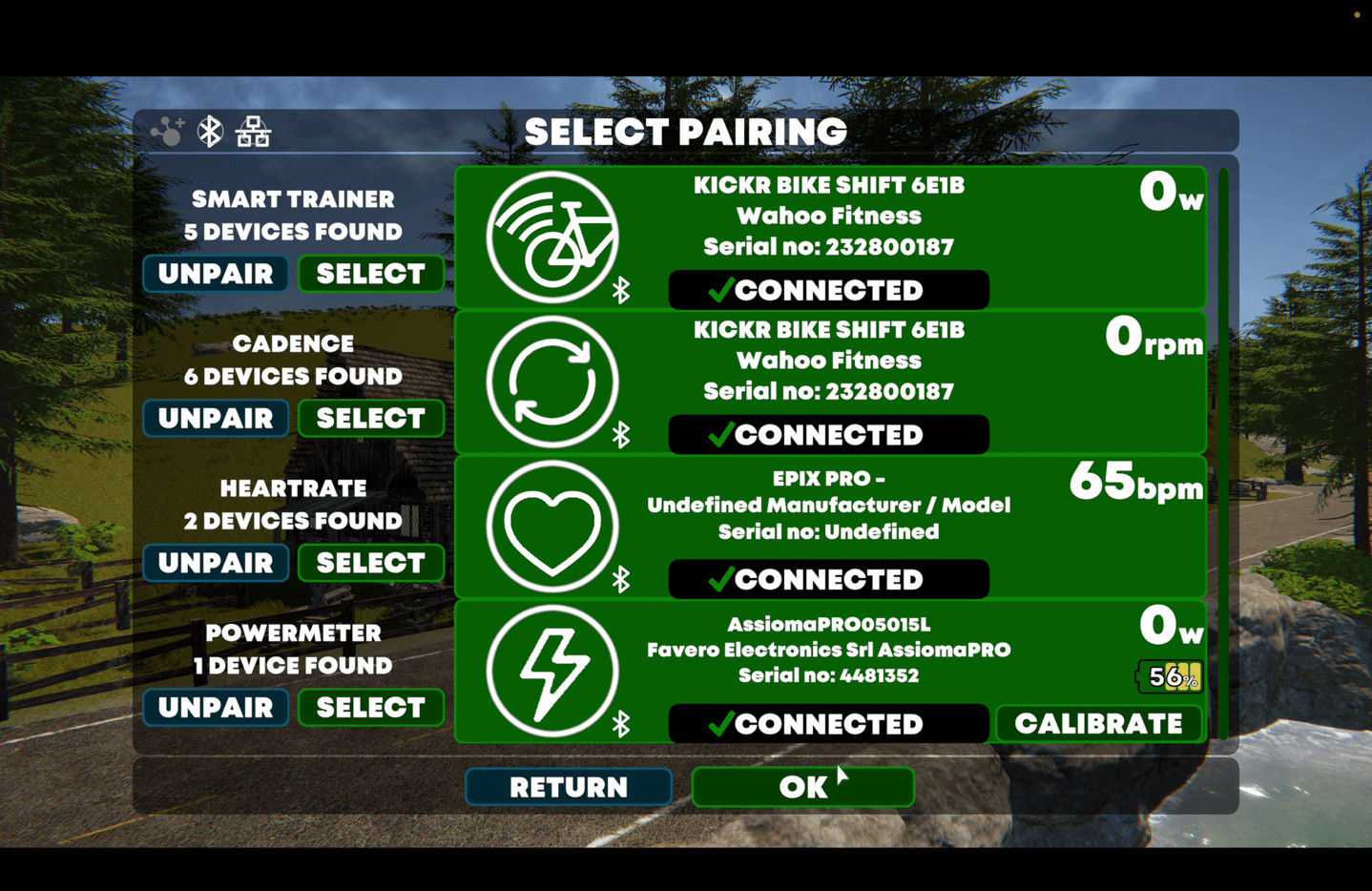 IndieVelo interface showing successful pairing with the Wahoo KICKR Bike Shift, ready for virtual cycling sessions.
IndieVelo interface showing successful pairing with the Wahoo KICKR Bike Shift, ready for virtual cycling sessions.
IndieVelo uniquely displays gear selection, unlike Zwift (as previously discussed). Both platforms support shifting functionality, but only IndieVelo provides visual gear feedback.
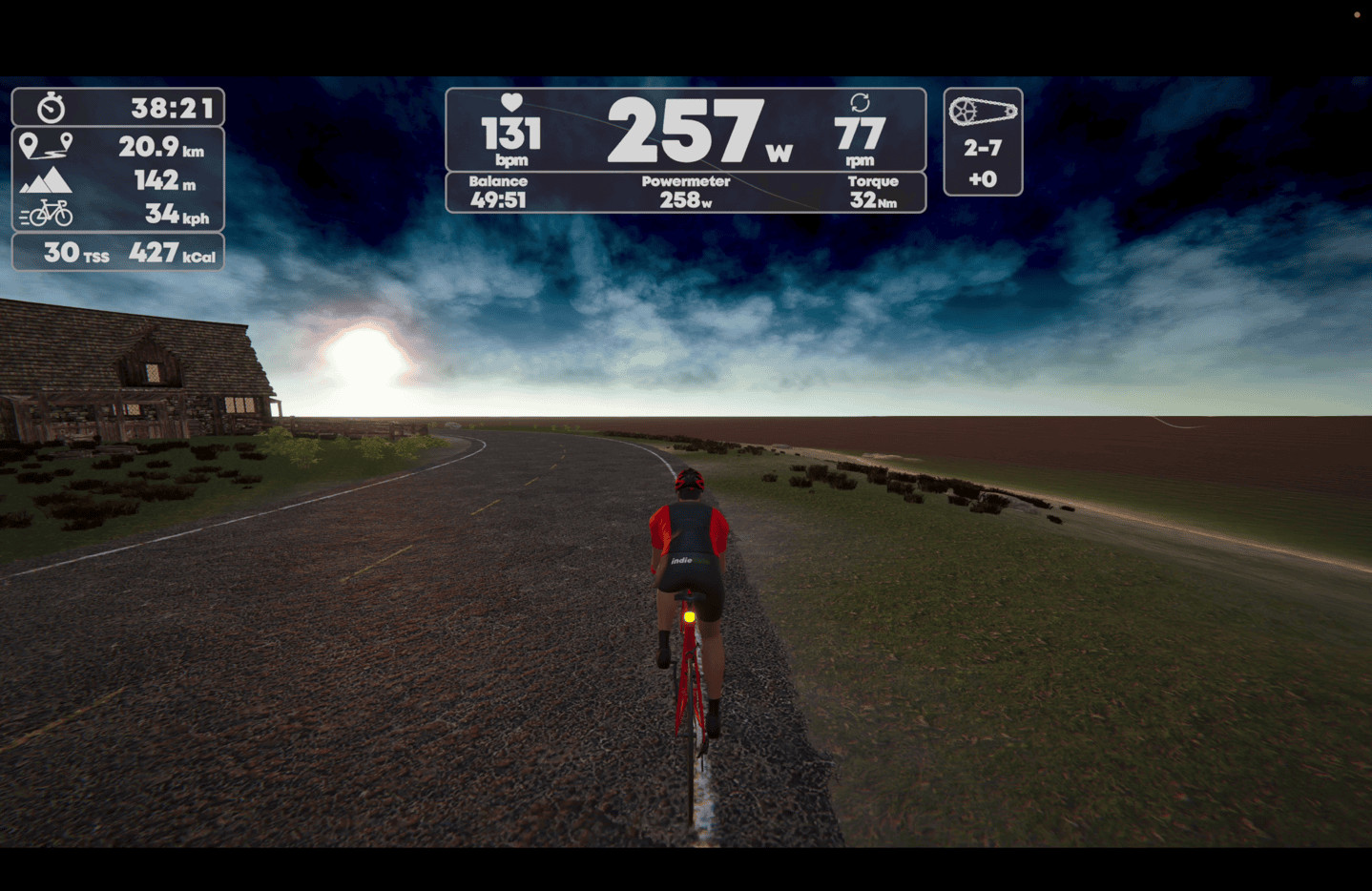 IndieVelo interface displaying current gear selection for the Wahoo KICKR Bike Shift, a feature not yet available in Zwift.
IndieVelo interface displaying current gear selection for the Wahoo KICKR Bike Shift, a feature not yet available in Zwift.
In Zwift, all core functionalities, including shifting and steering, operate correctly, although gear display remains pending. Gear display is less relevant in ERG mode, as shown below:
 Zwift workout screen with Wahoo KICKR Bike Shift in ERG mode, demonstrating structured training compatibility and stable power control.
Zwift workout screen with Wahoo KICKR Bike Shift in ERG mode, demonstrating structured training compatibility and stable power control.
I encountered no compatibility issues in either app in SIM mode, nor with TrainerRoad in ERG mode:
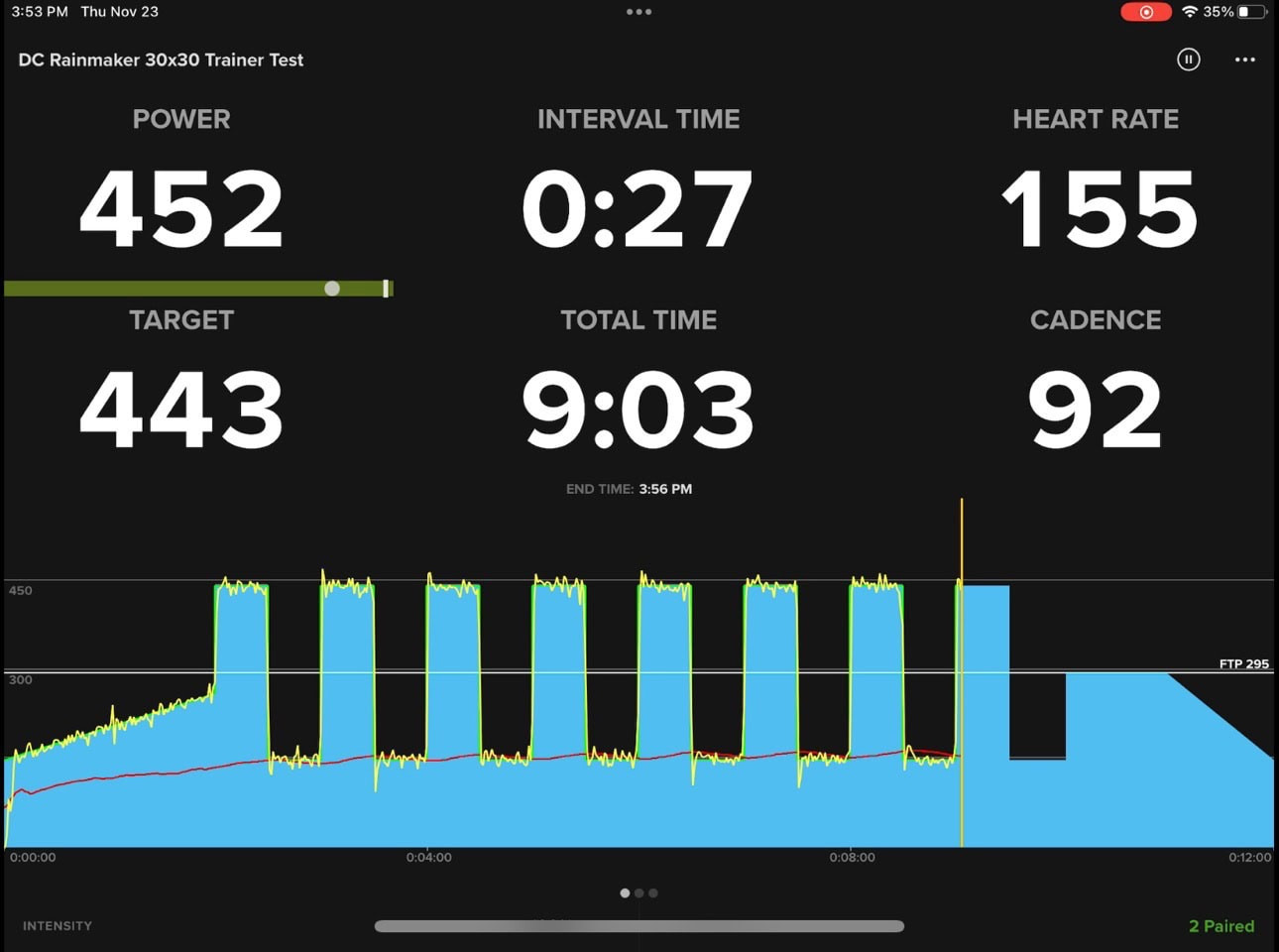 TrainerRoad workout screen showing successful connection and control of the Wahoo KICKR Bike Shift in ERG mode for structured training sessions.
TrainerRoad workout screen showing successful connection and control of the Wahoo KICKR Bike Shift in ERG mode for structured training sessions.
Occasionally, I used Zwift Play buttons with the KICKR BIKE SHIFT, which functioned flawlessly. These buttons provide quick access to various Zwift functions. Ideally, tighter integration between Zwift and Wahoo could streamline control schemes, potentially leveraging the SHIFT’s handlebar buttons for expanded in-game commands.
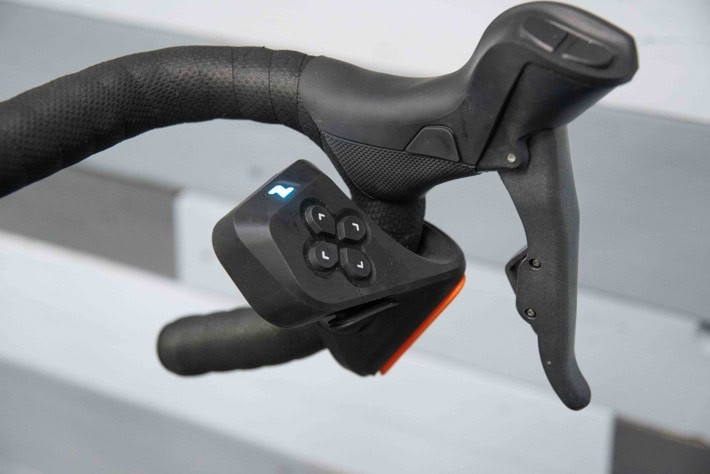 Images showing Zwift Play controllers mounted on the Wahoo KICKR Bike Shift handlebars, demonstrating compatibility with additional control accessories.
Images showing Zwift Play controllers mounted on the Wahoo KICKR Bike Shift handlebars, demonstrating compatibility with additional control accessories.
Overall, Zwift Play integration works seamlessly with the KICKR BIKE SHIFT setup.
Power Accuracy and Reliability
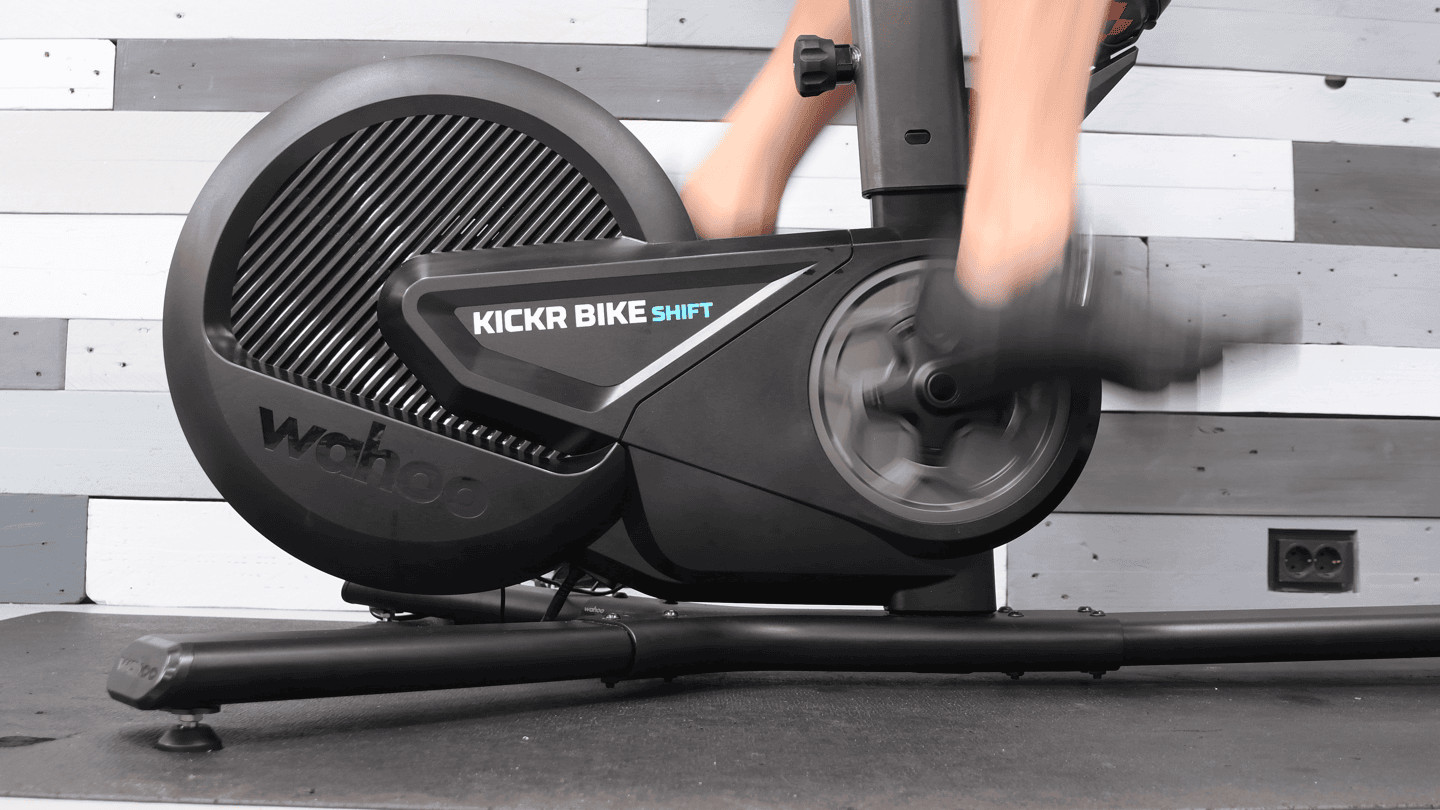 Close-up of the Wahoo KICKR Bike Shift’s resistance unit, highlighting the technology behind its power measurement and accuracy.
Close-up of the Wahoo KICKR Bike Shift’s resistance unit, highlighting the technology behind its power measurement and accuracy.
The extended duration of this review (nine months) is primarily attributed to initial power accuracy concerns. At launch, inaccuracies were present, stemming from a software bug that reset temperature compensation parameters with each firmware update, rendering them ineffective. This resulted in alternating periods of accurate and inaccurate power readings. Subsequently, for approximately a month, sporadic instances of inaccurate power data persisted. After pausing testing to address other product reviews, I resumed testing after several firmware updates, and power accuracy has been consistently reliable since mid-to-late November.
Therefore, to preempt the conclusion: Power accuracy has been consistently reliable since the aforementioned period.
My accuracy testing methodology involves comparing the KICKR BIKE SHIFT’s power readings against known-accurate power meters, assessing resistance control accuracy, responsiveness to power changes, and identifying any anomalies.
First, let’s examine responsiveness. While not directly related to accuracy, responsiveness – the speed at which the trainer adjusts resistance to match a target power – is crucial. Ideally, trainers should reach and stabilize at a target power within 2-4 seconds. Instantaneous resistance changes can feel jarring, while excessively slow response times can compromise interval training effectiveness.
For responsiveness testing, I typically perform a series of 30-second on/30-second off intervals. In this instance, the test was conducted in TrainerRoad. Analysis focuses on the time taken to reach and stabilize at the target power.
The data reveals that the KICKR BIKE SHIFT consistently reaches and stabilizes at the target wattage within 3 seconds for each interval. Wattage stabilization is also crucial; overshooting or undershooting the target wattage during the initial seconds of an interval can negatively impact training precision.
 Graph showing the Wahoo KICKR Bike Shift’s power response and stability during 30-second intervals in TrainerRoad, demonstrating quick and accurate wattage adjustments.
Graph showing the Wahoo KICKR Bike Shift’s power response and stability during 30-second intervals in TrainerRoad, demonstrating quick and accurate wattage adjustments.
Power accuracy is assessed by comparing the KICKR BIKE SHIFT’s readings to those of trusted power meters. In this test, Favero Assioma Duo pedals (Shimano variant) were used as the reference. The data shows close agreement between the two power sources, typically within a few watts.
Zooming in on the data reveals even closer agreement:
 Zoomed-in graph highlighting the close power accuracy agreement between the Wahoo KICKR Bike Shift and Favero Assioma Duo pedals during TrainerRoad intervals.
Zoomed-in graph highlighting the close power accuracy agreement between the Wahoo KICKR Bike Shift and Favero Assioma Duo pedals during TrainerRoad intervals.
Establishing this baseline accuracy, let’s examine data from a longer ERG workout performed recently, also consisting of 30-second intervals. This dataset demonstrates the remarkable consistency between the KICKR BIKE SHIFT and Favero Assioma MX2 Pro pedals.
Zooming into the data reveals power discrepancies typically within 1-3 watts:
 Detailed graph showing minimal power difference between the Wahoo KICKR Bike Shift and Favero Assioma MX2 Pro pedals during a longer interval workout.
Detailed graph showing minimal power difference between the Wahoo KICKR Bike Shift and Favero Assioma MX2 Pro pedals during a longer interval workout.
Cadence readings are also virtually identical. However, the graph scaling can be misleading due to multi-second averaging.
The mean-max power curve further illustrates the close agreement, with differences of only 3 watts across various power durations:
 Mean-max power curve comparing the Wahoo KICKR Bike Shift and Favero Assioma MX2 Pro pedals, showing consistent power output across different durations.
Mean-max power curve comparing the Wahoo KICKR Bike Shift and Favero Assioma MX2 Pro pedals, showing consistent power output across different durations.
Moving to SIM mode testing, this workout was performed in Indievelo on undulating terrain:
Zooming into sprint segments reveals slight discrepancies at peak 1-second power values. In some instances, the Favero MX pedals register higher power than the KICKR BIKE SHIFT:
 Graph showing slight power differences during sprints between the Wahoo KICKR Bike Shift and Favero Assioma MX pedals in IndieVelo’s simulation mode.
Graph showing slight power differences during sprints between the Wahoo KICKR Bike Shift and Favero Assioma MX pedals in IndieVelo’s simulation mode.
Conversely, in other sprint efforts, the SHIFT registers slightly higher power than the Favero pedals:
Analysis across numerous scenarios has not revealed a consistent pattern explaining these minor discrepancies.
Cadence agreement remains excellent:
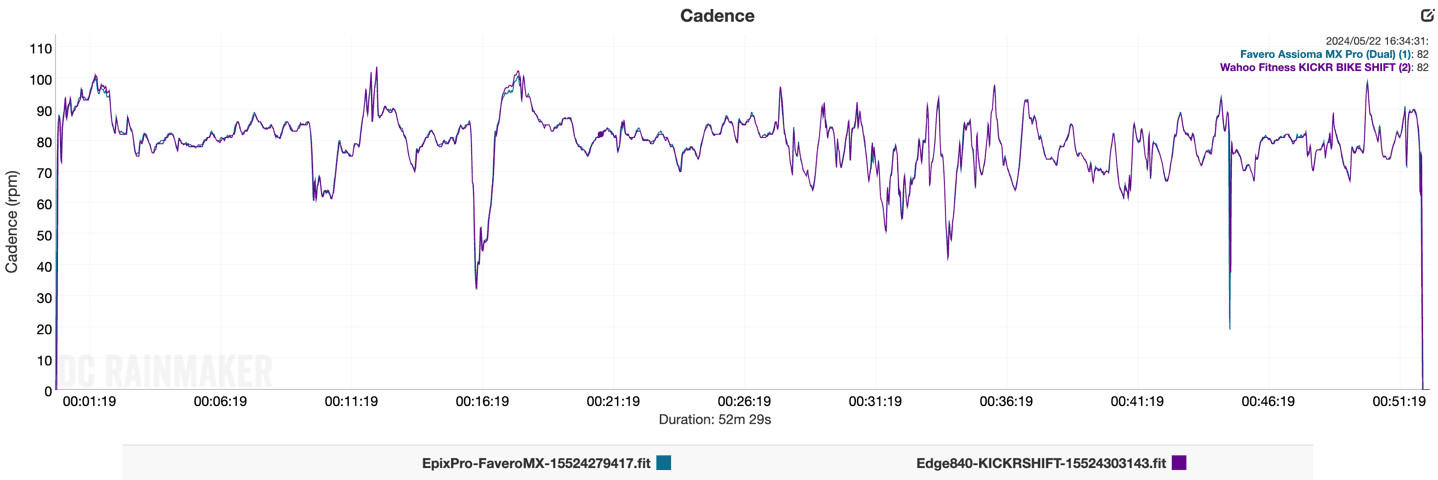 Cadence comparison graph showing virtually identical readings between the Wahoo KICKR Bike Shift and Favero Assioma MX pedals during the simulation mode workout.
Cadence comparison graph showing virtually identical readings between the Wahoo KICKR Bike Shift and Favero Assioma MX pedals during the simulation mode workout.
The mean-max power curve again demonstrates very close agreement:
Here’s another simulation mode workout, incorporating sprints towards the end:
 Overall power graph from a simulation mode workout, comparing the Wahoo KICKR Bike Shift and Favero Assioma MX pedals over varying terrain.
Overall power graph from a simulation mode workout, comparing the Wahoo KICKR Bike Shift and Favero Assioma MX pedals over varying terrain.
Sprints and surges (analyzed with 3-second averaging) show very close power agreement, within a few watts, which is challenging to achieve at high power outputs due to data transmission and recording timing variations:
Cadence accuracy remains consistent:
 Cadence graph from the simulation mode workout, confirming accurate cadence measurement by the Wahoo KICKR Bike Shift, aligning with external power meter pedals.
Cadence graph from the simulation mode workout, confirming accurate cadence measurement by the Wahoo KICKR Bike Shift, aligning with external power meter pedals.
The mean-max power curve further confirms the excellent power accuracy:
In conclusion, while initial power accuracy issues were present during the KICKR BIKE SHIFT’s launch period, subsequent software updates have effectively resolved these concerns.
Currently, in terms of responsiveness, accuracy, and stability, the KICKR BIKE SHIFT exhibits no discernible issues when compared to multiple trusted power meter pedals.
Indoor Smart Bike Comparison
The KICKR Bike SHIFT has been added to the product comparison database. For this comparison, it is placed alongside the Wahoo KICKR Bike V2, Tacx NEO Bike Plus, and Wattbike ATOM 2020. With Stages Cycling’s recent business closure, the Stages SB20, which would typically be included, is omitted. As a general rule, products are only included in the comparison database after hands-on testing. Therefore, newer models like the Decathlon indoor bike are not yet included.
| Function/Feature | Wahoo KICKR BIKE SHIFT | Wahoo KICKR Bike V2 | Tacx NEO Bike Plus | Wattbike ATOM 2020 |
|---|---|---|---|---|
| Copyright DC Rainmaker – Updated June 12th, 2024 @ 8:07 pm New Window | ||||
| Price for trainer | $2,999 | $3,999 | $3,999 | $2,599 |
| Trainer Type | Indoor Bike | Indoor Bike | Indoor Bike | Indoor Bike |
| Available today (for sale) | Yes | Yes | Yes | Yes |
| Availability regions | Limited Initially | Limited Initially | Global | UK/South Africa/Australia/Scandinavia/USA |
| Wired or Wireless data transmission/control | Wireless | Wireless | Wireless | Wireless |
| Power cord required | Yes | Yes | No | Yes |
| Flywheel weight | 13bs/5.9kgs | Simulated/Virtual 125KG | 9.28KG/20.4lbs | |
| Resistance | Wahoo KICKR BIKE SHIFT | Wahoo KICKR Bike V2 | Tacx NEO Bike Plus | Wattbike ATOM 2020 |
| Includes motor to drive speed (simulate downhill) | No | Yes | Yes | No |
| Maximum wattage capability | 2,200w @ 40KPH | 2,200w @ 40KPH | 2,200w @ 40KPH | 2,500w |
| Maximum simulated hill incline | 20% (and -15% downhill) | 20% (and -15% downhill) | 25% | 25% |
| Features | Wahoo KICKR BIKE SHIFT | Wahoo KICKR Bike V2 | Tacx NEO Bike Plus | Wattbike ATOM 2020 |
| Measures/Estimates Left/Right Power | No | No | Yes | Yes |
| Can directionally steer trainer (left/right) | Yes (with compatible apps) | Yes (with compatible apps) | YES (WITH COMPATIBLE APPS) | Yes (with compatible apps) |
| Can simulate road patterns/shaking (i.e. cobblestones) | No | No | Yes | No |
| Motion | Wahoo KICKR BIKE SHIFT | Wahoo KICKR Bike V2 | Tacx NEO Bike Plus | Wattbike ATOM 2020 |
| Can slide forward/back with movement | No | No | No | No |
| Can rock/tilt side to side (significantly) | No | No | No | No |
| Accuracy | Wahoo KICKR BIKE SHIFT | Wahoo KICKR Bike V2 | Tacx NEO Bike Plus | Wattbike ATOM 2020 |
| Supported accuracy level | +/- 1% | +/- 1% | +/- 1% | +/- 2% |
| Trainer Control | Wahoo KICKR BIKE SHIFT | Wahoo KICKR Bike V2 | Tacx NEO Bike Plus | Wattbike ATOM 2020 |
| Supports ANT+ FE-C (Trainer Control Standard) | Yes | Yes | Yes | Yes |
| Supports Bluetooth Smart FTMS (Trainer Control Standard) | Yes | Yes | Yes | Yes |
| WiFi or Ethernet | WiFi (Ethernet with accessory) | WIFI (ETHERNET WITH ACCESSORY) | No | No |
| Data Broadcast | Wahoo KICKR BIKE SHIFT | Wahoo KICKR Bike V2 | Tacx NEO Bike Plus | Wattbike ATOM 2020 |
| Transmits power via Bluetooth Smart | Yes | Yes | Yes | Yes |
| Supports Multiple Concurrent Bluetooth connections | Yes, 3 Concurrent | Yes, 3 Concurrent | No, just one | Yes |
| Transmits cadence data | Yes | Yes | Yes | Yes |
| Bridging or re-transmission | No | No | No | No |
| Race Mode (High Speed Data) | No | Yes (Beta) | No | |
| Indoor Bike Features | Wahoo KICKR BIKE SHIFT | Wahoo KICKR Bike V2 | Tacx NEO Bike Plus | Wattbike ATOM 2020 |
| Can customize shifting (Shimano/SRAM/Campagnolo) | Yes (Shimano/SRAM/Campagnolo) | Yes (Shimano/SRAM/Campagnolo) | Yes | No |
| Can customize gearing | Yes (both cassette and chainrings) | Yes (both cassette and chainrings) | Yes | Yes |
| Supported Crank Lengths | 165/167.5/170/172.5/175mm | 165/167.5/170/172.5/175mm | 170/172.5/175mm | 170mm |
| Display | No | Small display near top-tube | Yes | No |
| USB Ports | No | 1 USB port | 2 USB Ports (2AMP) | No |
| Purchase | Wahoo KICKR BIKE SHIFT | Wahoo KICKR Bike V2 | Tacx NEO Bike Plus | Wattbike ATOM 2020 |
| Backcountry.com | Link | |||
| Competitive Cyclist | Link | Link | Link | |
| REI | Link | |||
| DCRainmaker | Wahoo KICKR BIKE SHIFT | Wahoo KICKR Bike V2 | Tacx NEO Bike Plus | Wattbike ATOM 2020 |
Expect more bike additions to this comparison table soon, including the Mouv bike, which has been under evaluation at the DCR Cave for several months.
Final Verdict: Is the Wahoo KICKR BIKE SHIFT Right for You?
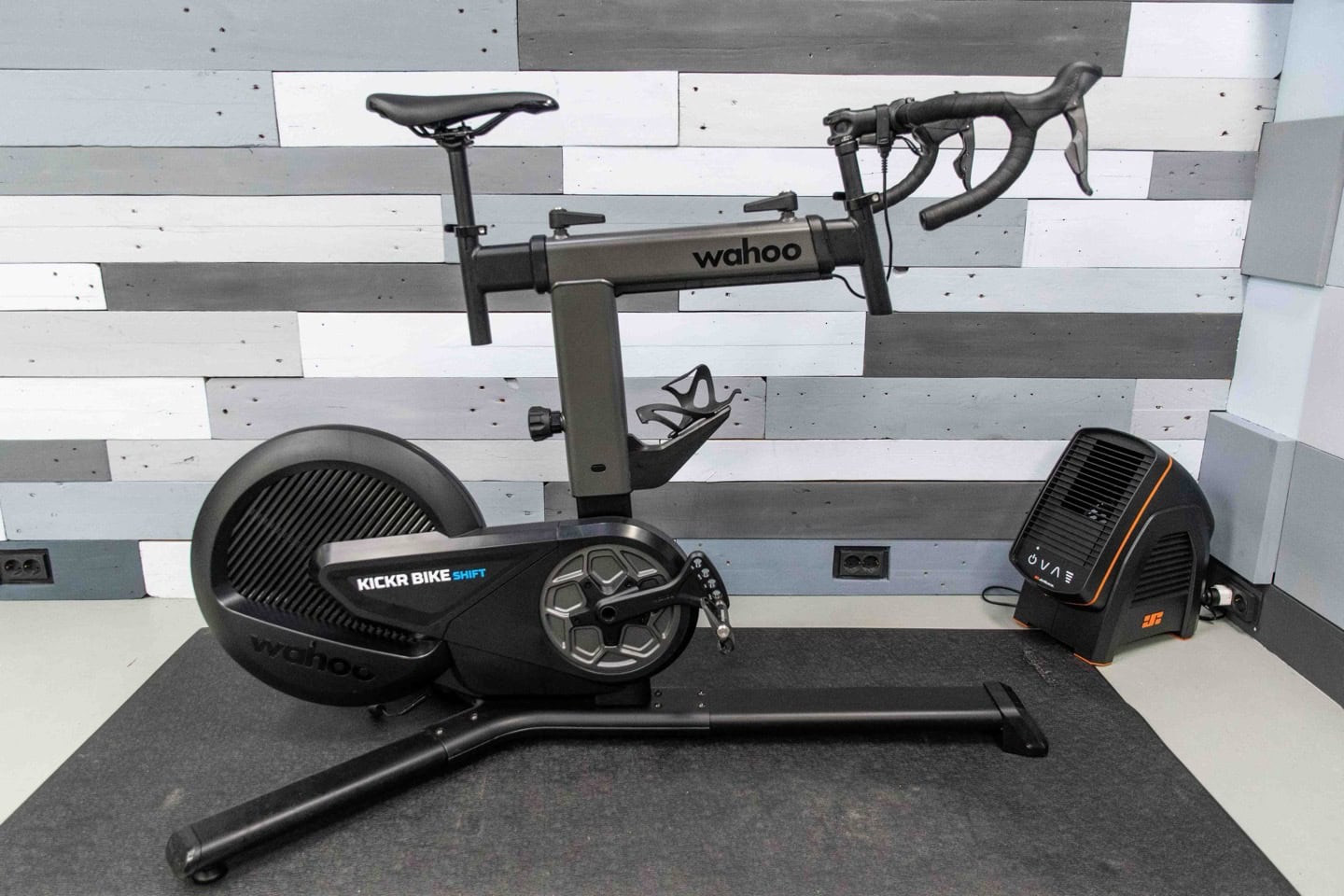 Concluding image of the Wahoo KICKR Bike Shift, summarizing its key features and positioning in the smart bike market.
Concluding image of the Wahoo KICKR Bike Shift, summarizing its key features and positioning in the smart bike market.
The indoor smart bike market offers a diverse range of options, from exceptional performers to subpar offerings, with many falling in between. The KICKR BIKE SHIFT unequivocally belongs to the “exceptional” category, particularly considering its more accessible price point compared to the premium KICKR BIKE V2. While it forgoes the physical incline/decline simulation of the V2, it excels in virtually every other aspect. As many KICKR BIKE owners, including myself, have observed, the KICKR CLIMB functionality is often underutilized. While a compelling feature, it may not justify the price premium for all users. Similarly, the KICKR Race Mode’s high-speed data transmission will only appeal to a niche segment of performance-focused riders.
Furthermore, the KICKR BIKE SHIFT benefits from a simpler, more robust design with fewer potential failure points. The original KICKR BIKE V1, like many first-generation smart bikes, encountered various hardware issues. The V2 addressed many of these concerns, and Wahoo’s design modifications in the V2 primarily aimed to enhance hardware reliability. The SHIFT’s design further emphasizes hardware simplification and cost reduction, resulting in a remarkably robust and dependable smart bike.
Post-launch user feedback for the KICKR BIKE SHIFT has been generally positive, with most owners expressing satisfaction. While isolated hardware failures have been reported, the overall incidence appears significantly lower than previous Wahoo bike generations. However, the absence of KICKR Race Mode in the $3,000 SHIFT, while present in the more affordable $1,200 Wahoo trainer, remains a point of contention for some.
Ultimately, if you are in the market for an indoor smart bike, the Wahoo KICKR BIKE SHIFT is a strong contender. The market has seen numerous new entrants recently, warranting a comprehensive comparison post in the near future. In the meantime, thank you for reading this in-depth review!
Support usabikers.net – Keep the Reviews Coming!
We hope you found this review helpful. Our goal is to provide detailed, unbiased information to assist you in making informed purchasing decisions. Our reviews are conducted from an athlete’s perspective, focusing on real-world usage and in-depth analysis. Crafting these detailed reviews requires significant time and effort, and we are committed to providing comprehensive information. We also dedicate time to respond to reader questions in the comments section below.
If you are considering purchasing the Wahoo KICKR BIKE SHIFT or related accessories, please support usabikers.net by using the affiliate links provided below. As an Amazon Associate, we earn from qualifying purchases. This support does not increase your cost but significantly contributes to the maintenance and growth of this website.

Wahoo KICKR BIKE SHIFT
Here are some recommended accessories to enhance your Wahoo KICKR BIKE SHIFT experience:
Wahoo Trainer Floor Mat
Amazon $80 Backcountry Competitive Cyclist REI $80
Wahoo Headwind Fan
Amazon $255 Backcountry $300 Competitive Cyclist $300 REI $300
Wahoo KICKR Desk
Amazon $270 Backcountry $250 Competitive Cyclist $250
Here are some other essential smart bike accessories for new owners:
Apple TV 4K
For Zwift and other virtual cycling apps on your TV, Apple TV 4K is a top choice for performance and value. It’s my primary Zwift platform, offering superior graphics even for non-4K TVs.
Basic Trainer Mat
A basic trainer mat protects your floors from sweat and reduces vibrations. Simple and effective.
Elago R1 Apple TV Remote Silicone Case with Strap
Enhance your Apple TV remote with this silicone case and strap for better grip and handlebar mounting. Note: Not for 2021 Apple TV Edition.
Honeywell HT-900 Fan
These affordable fans are effective for cooling during indoor rides. I use multiple in the DCR Cave.
Lasko High Velocity Pro-Performance Fan (U15617)
A powerful and popular trainer fan, offering performance comparable to the Wahoo Headwind at a lower price.
Indoor Cycle Trainer Desk (RAD/CXWXC/Vinsetto/Conquer/etc…)
This desk is a cost-effective and improved alternative to the KICKR Desk, featuring wheel locks and dual water bottle holders. Branding varies by region, but the desk is the same.
KOM Cycling Trainer Desk
The KOM Cycling Trainer Desk offers excellent value with multi-tier tablet slots, bottle holders, and adjustable height. Highly recommended for its features and price.
Consider becoming a usabikers.net Supporter for an ad-free experience, exclusive content, and to support our independent reviews. Your support is greatly appreciated!
Thank you for reading! Please feel free to leave comments and questions below. We appreciate your feedback on this review.
0 Shares

